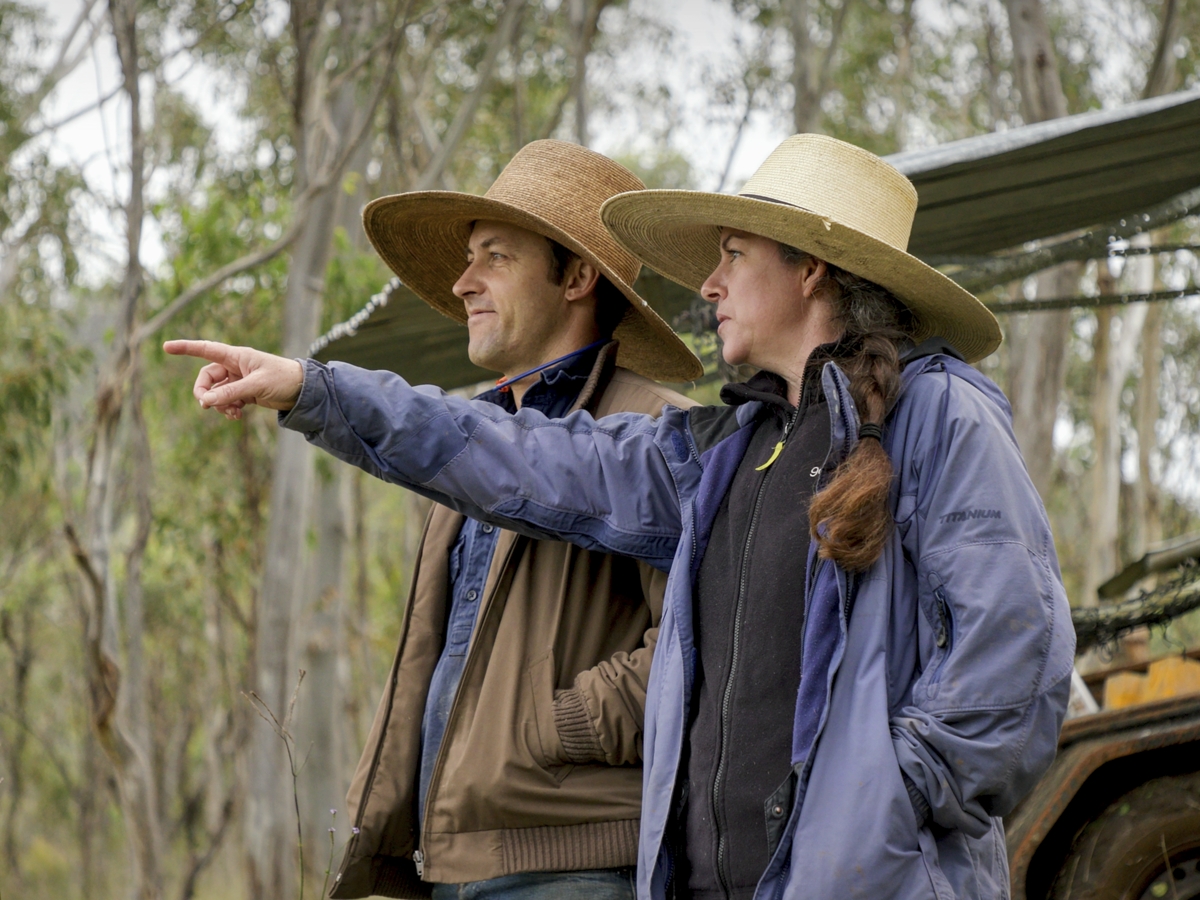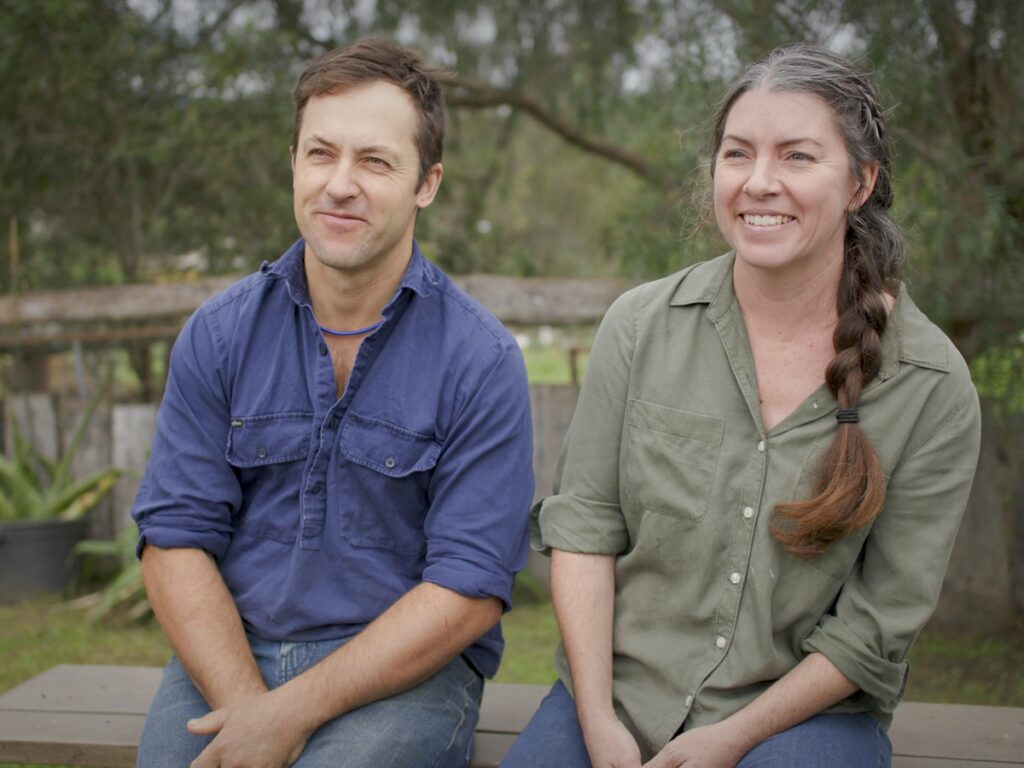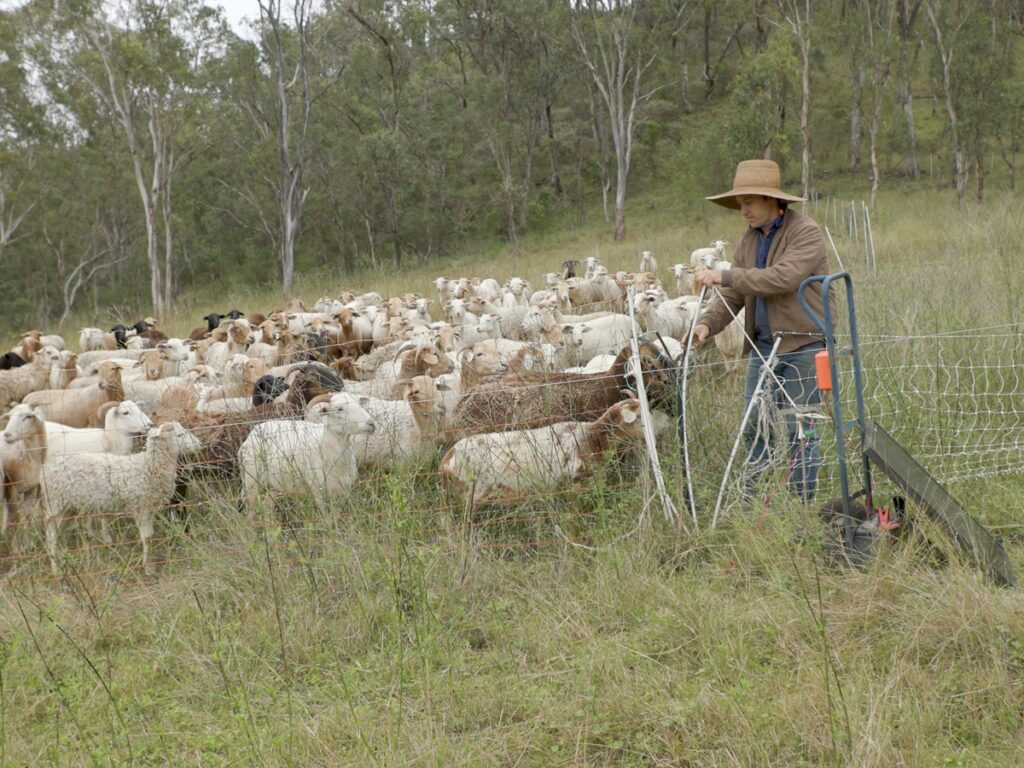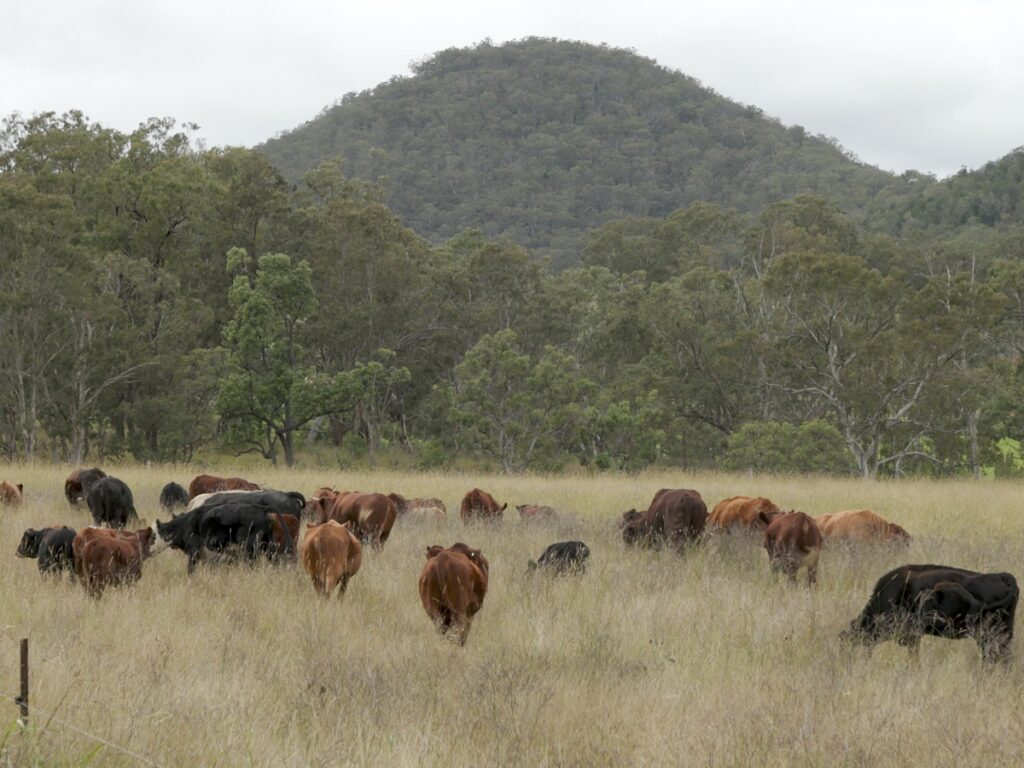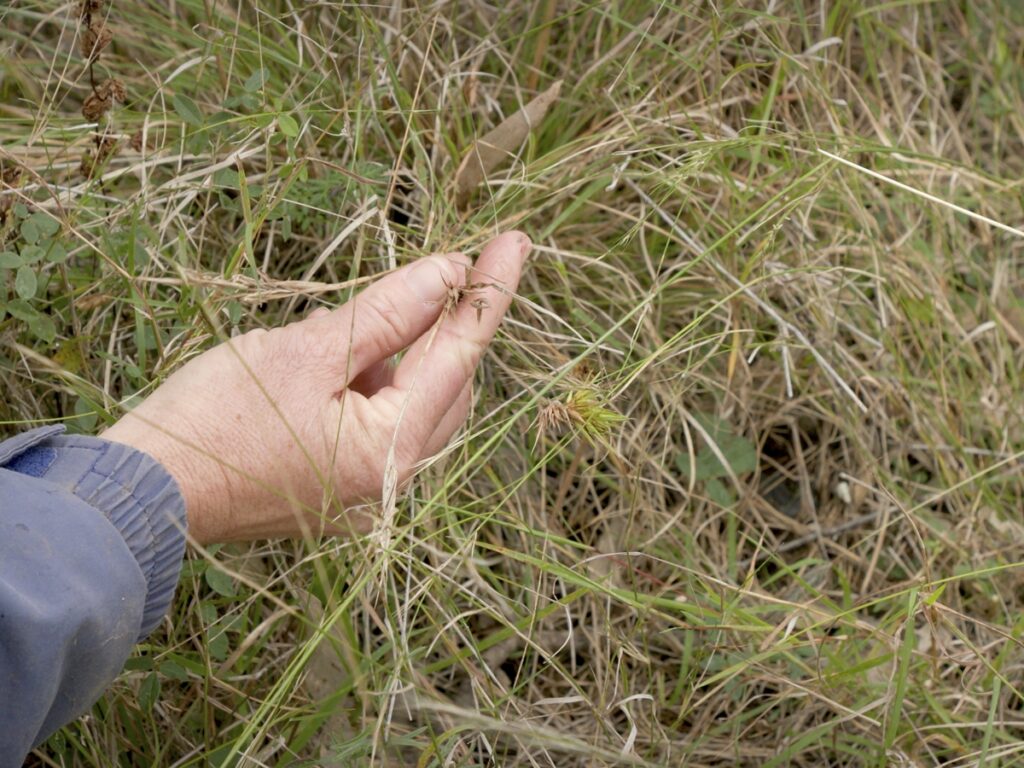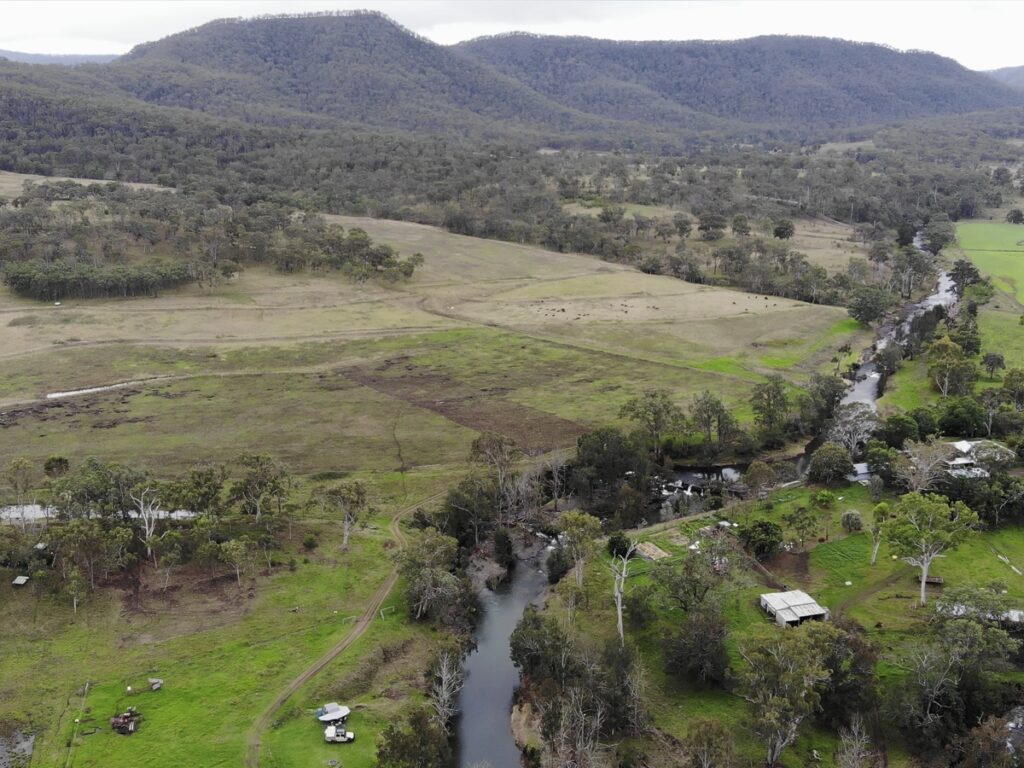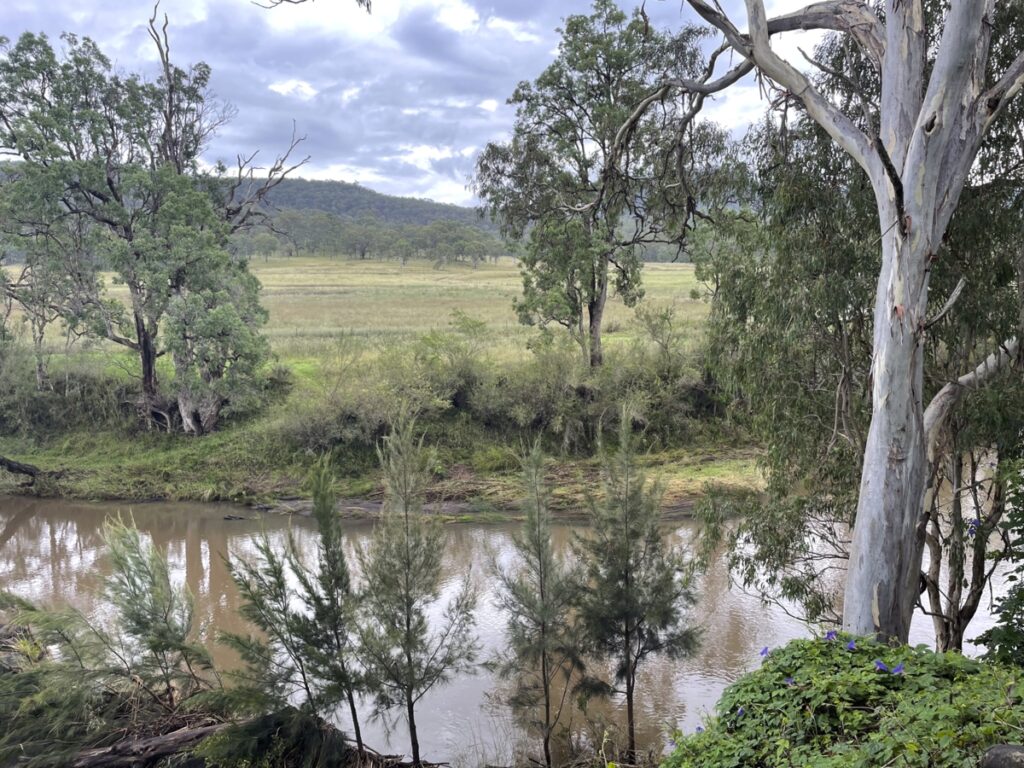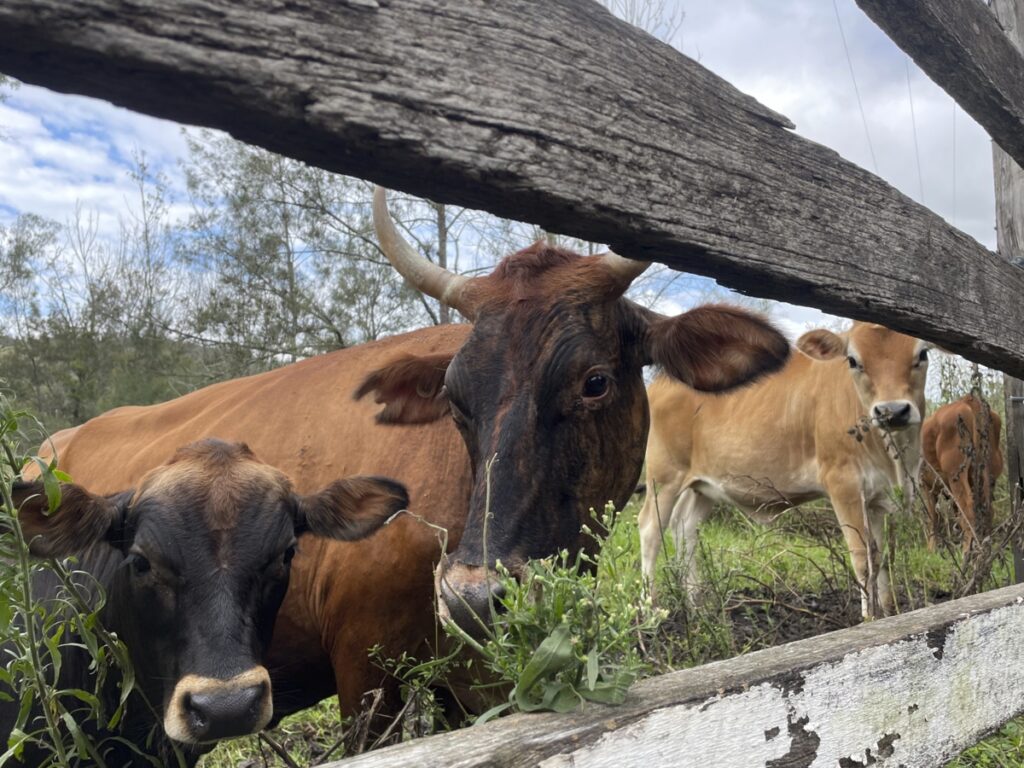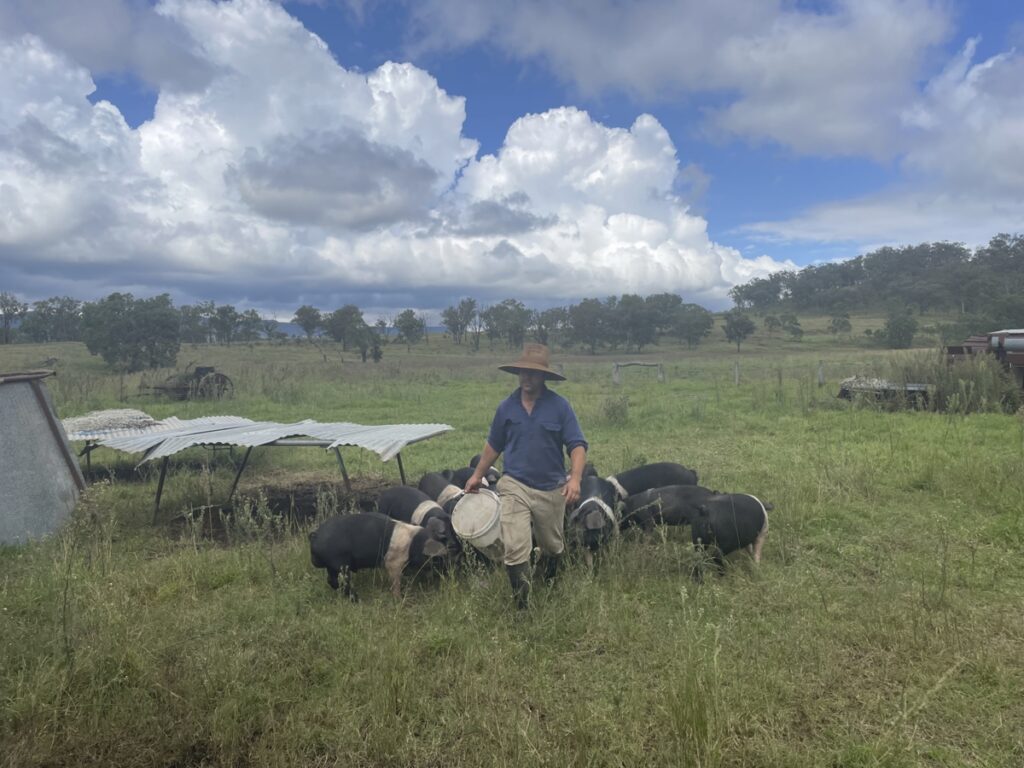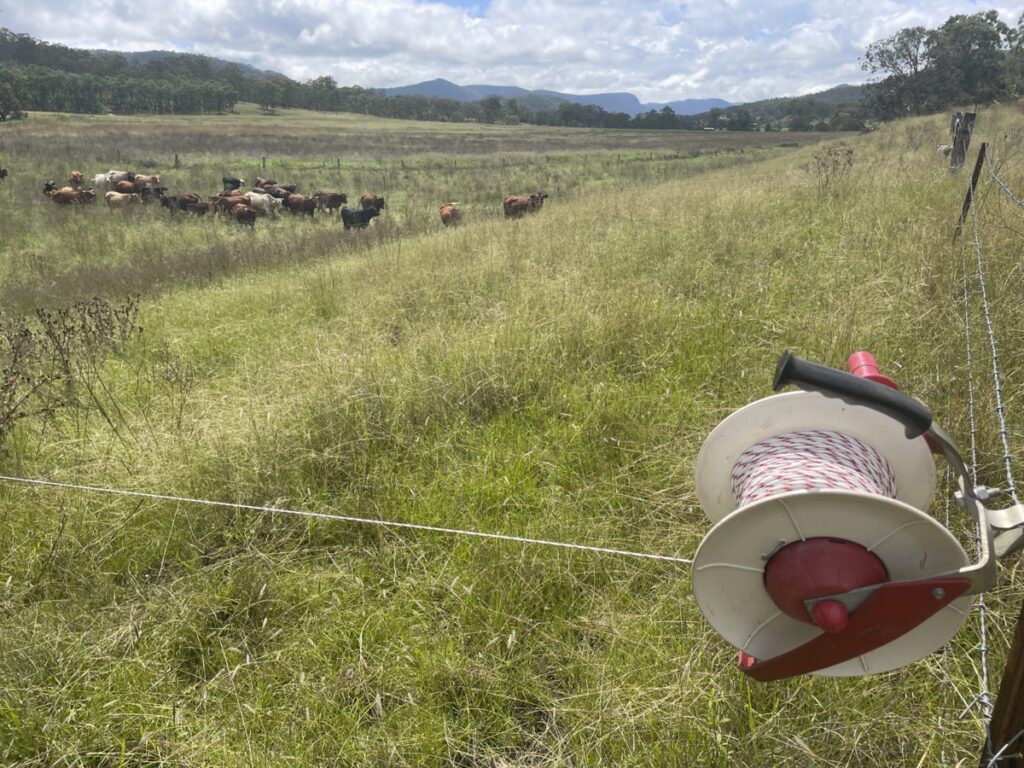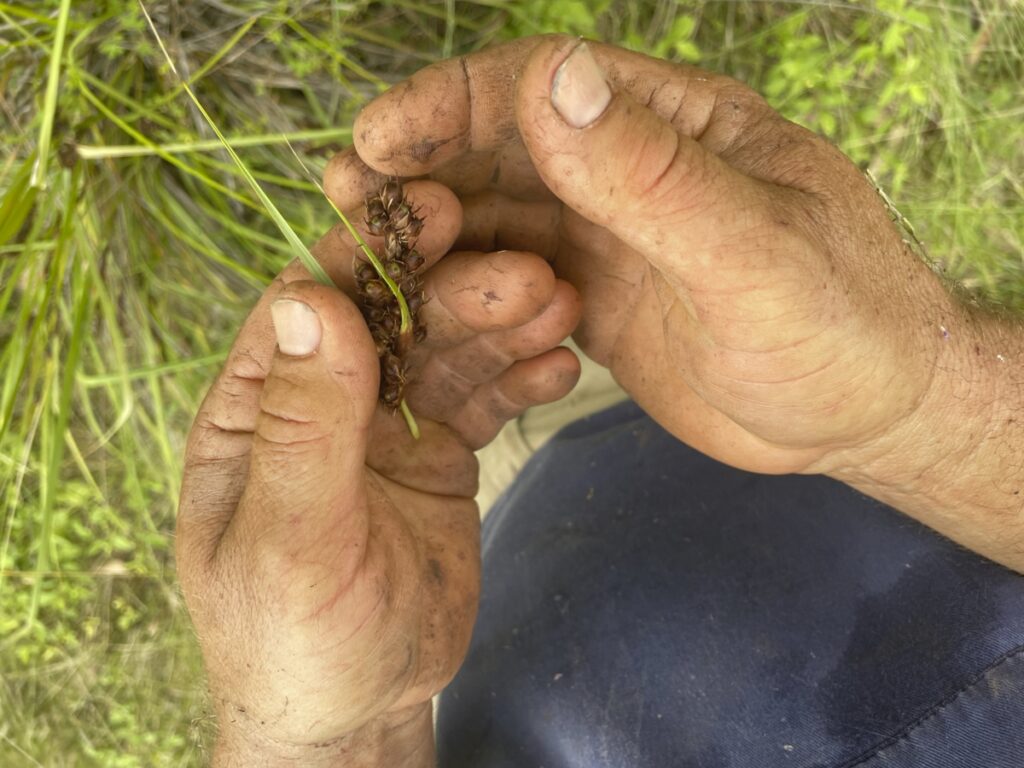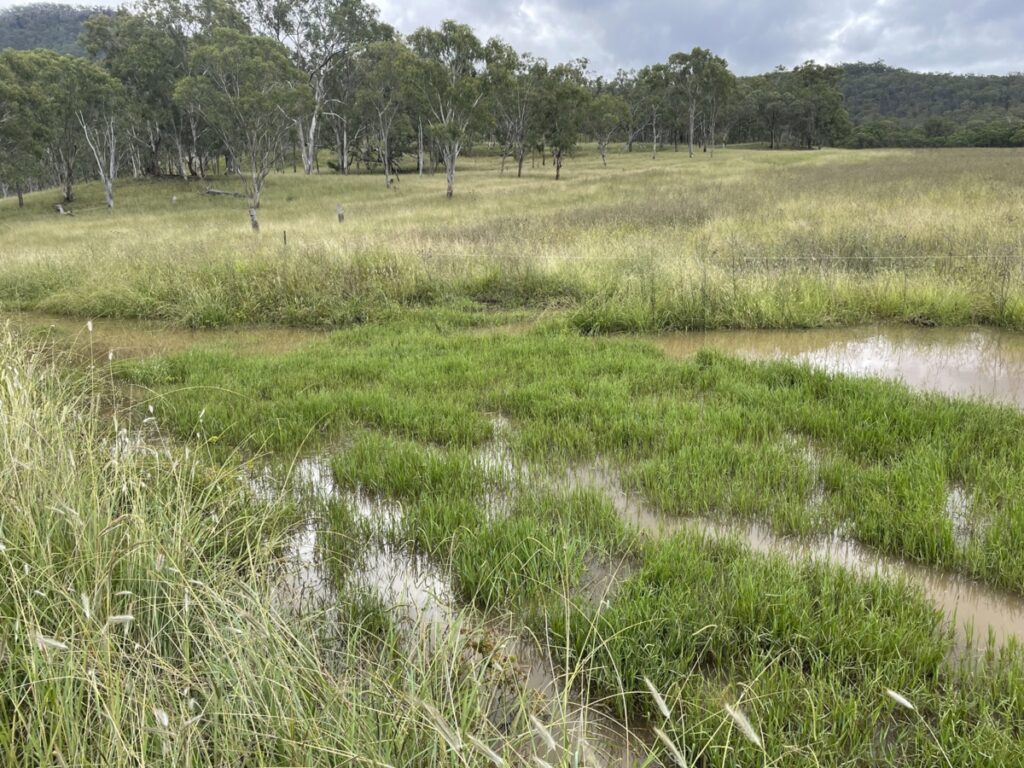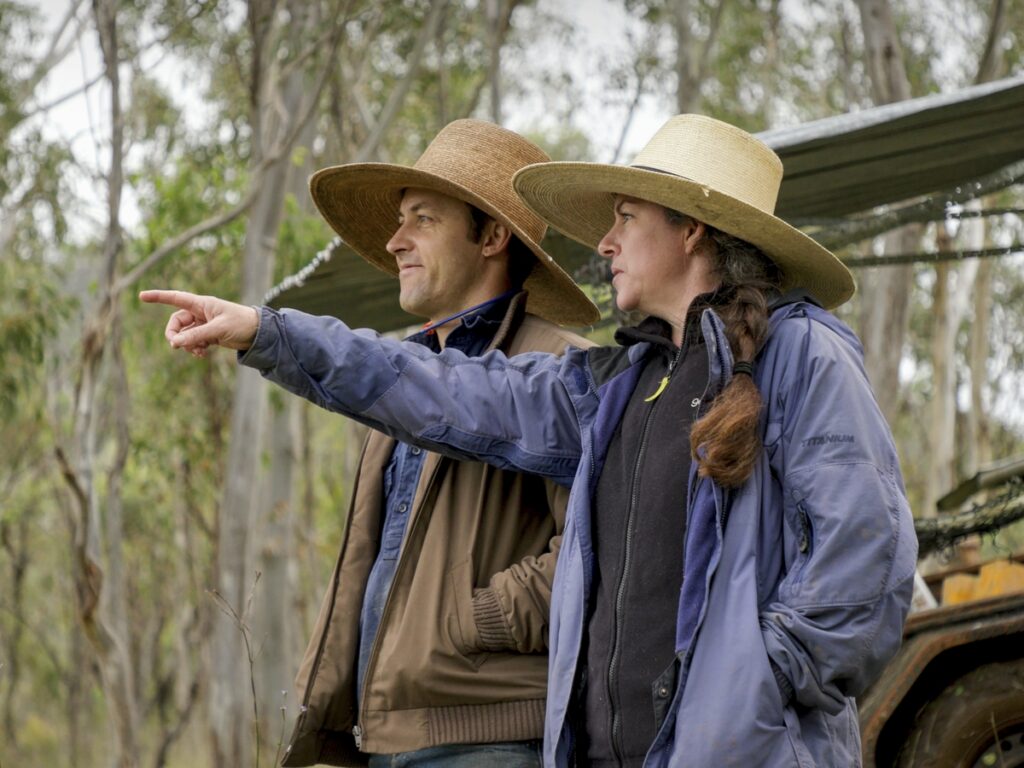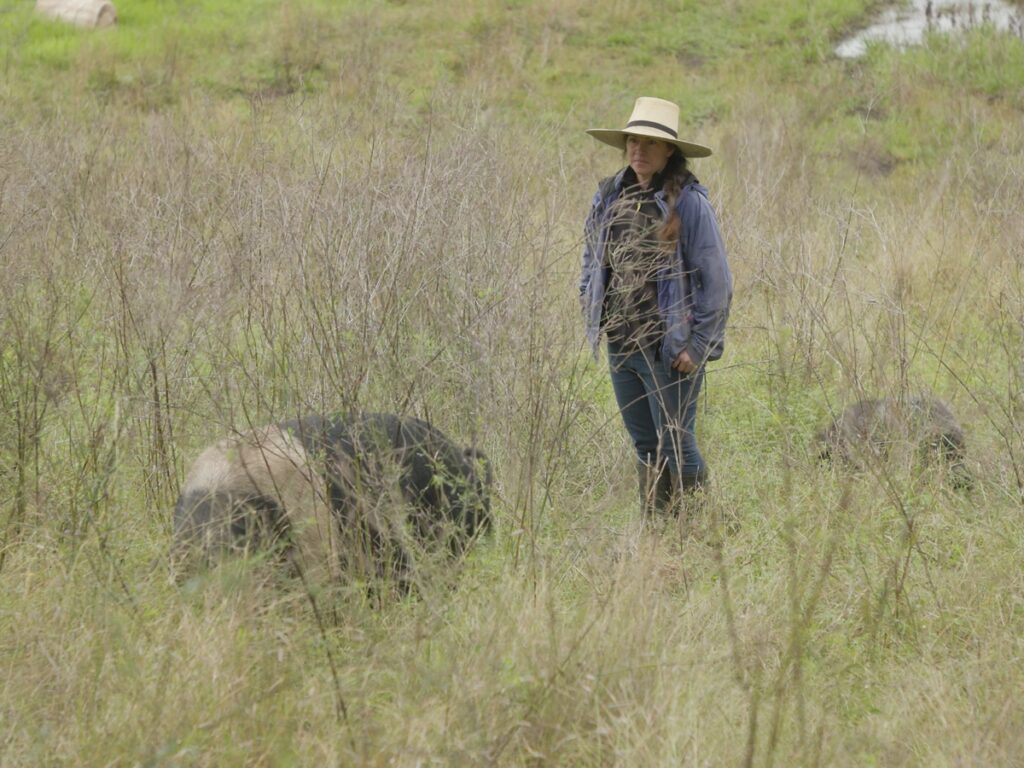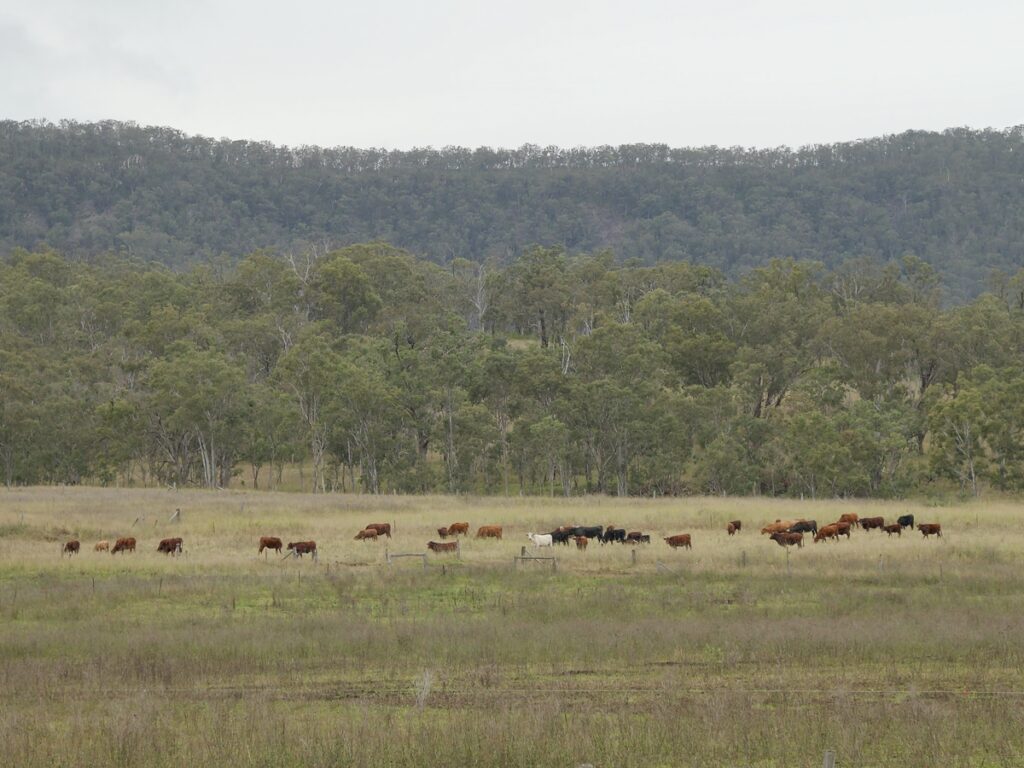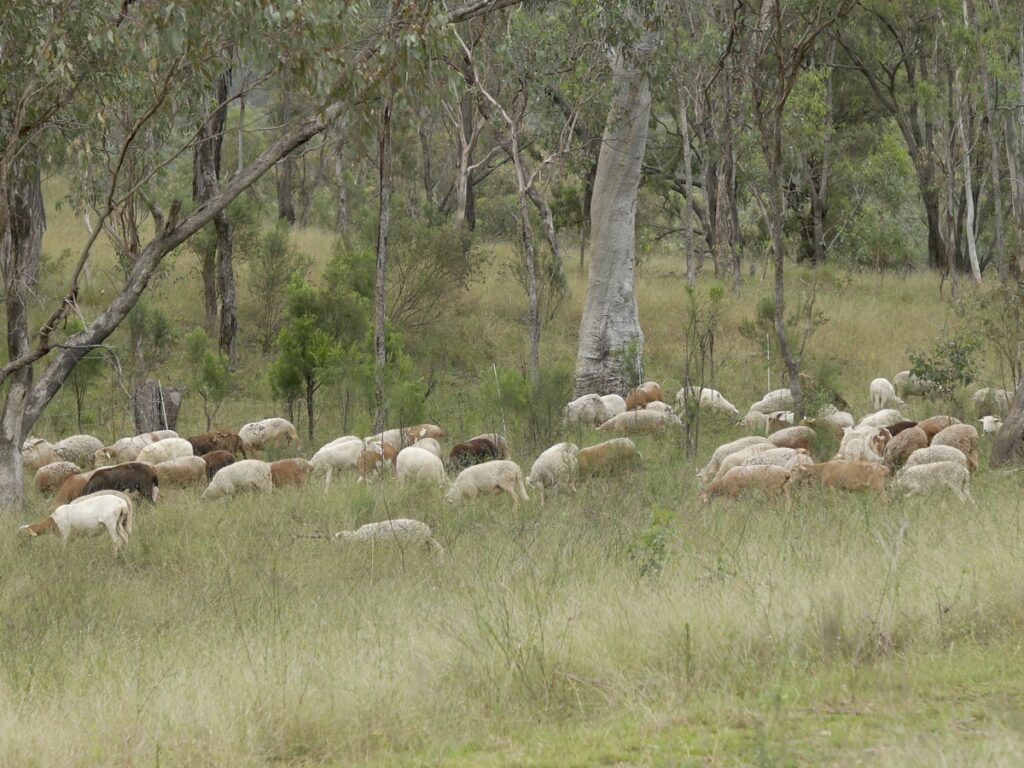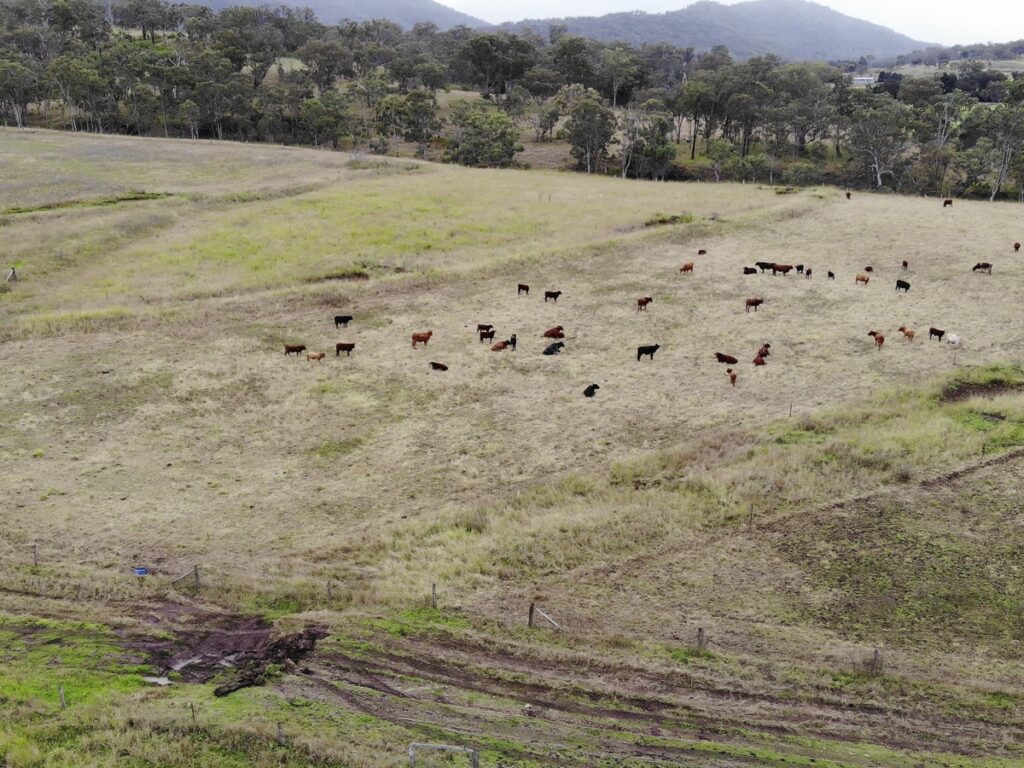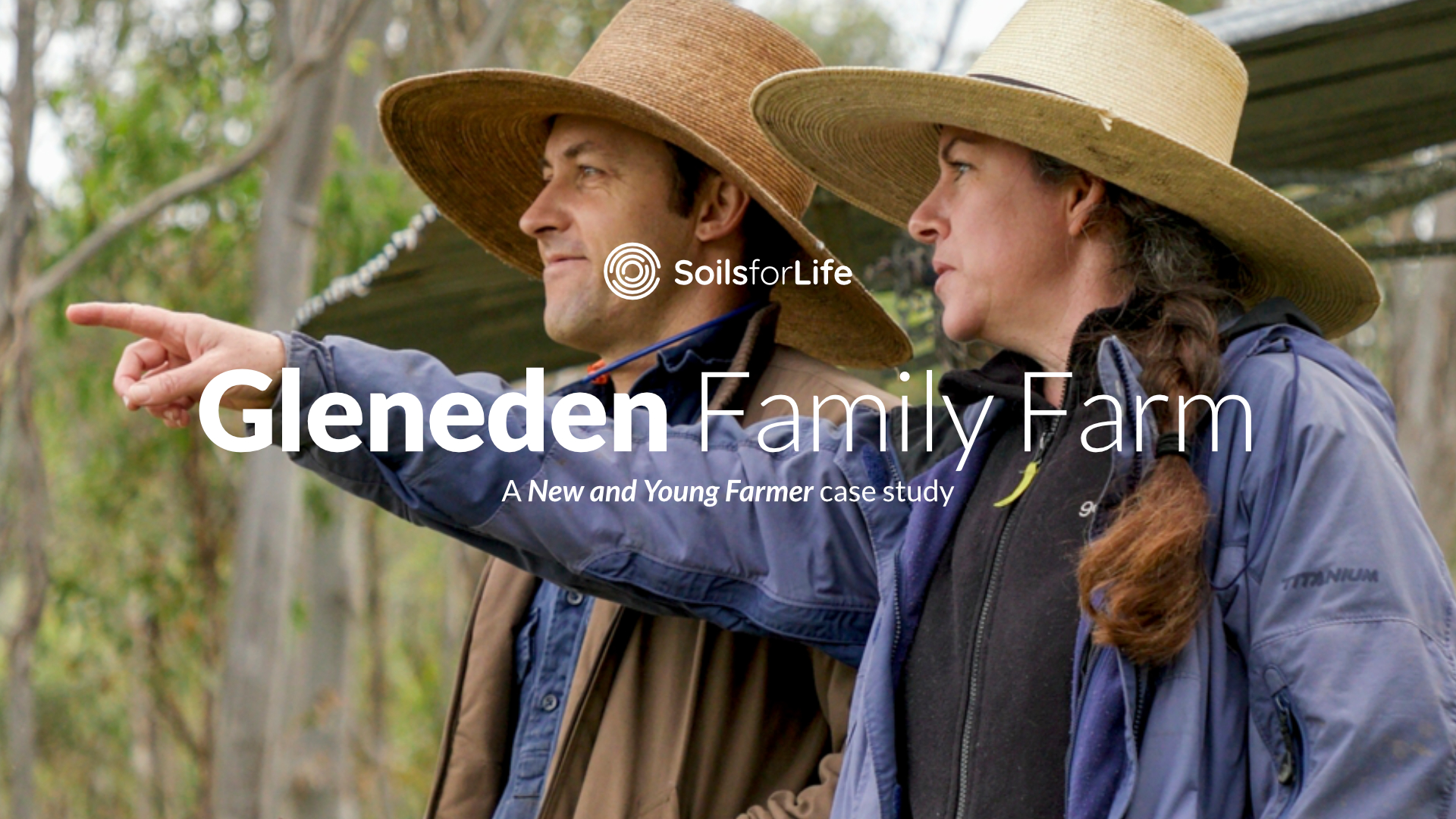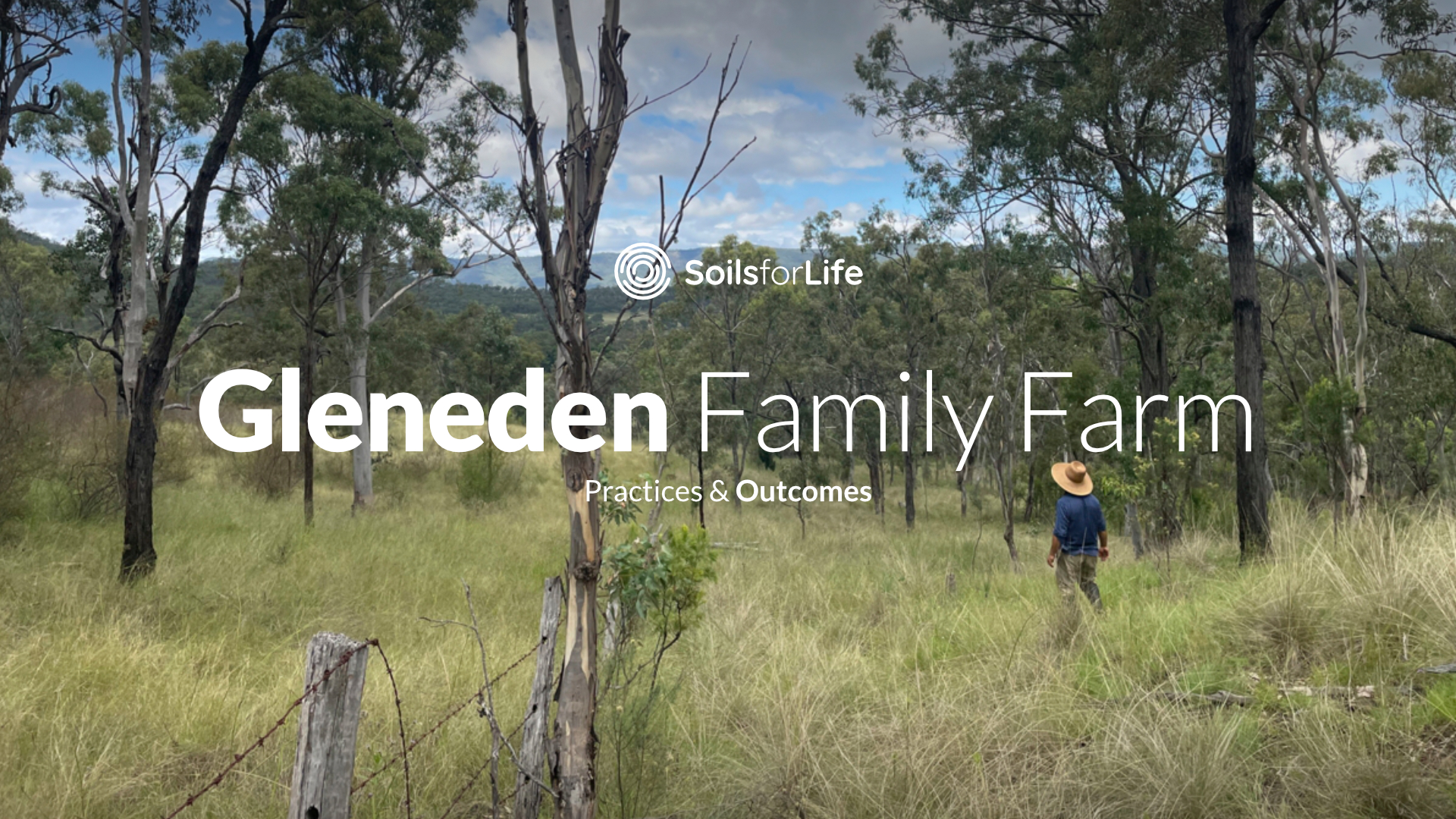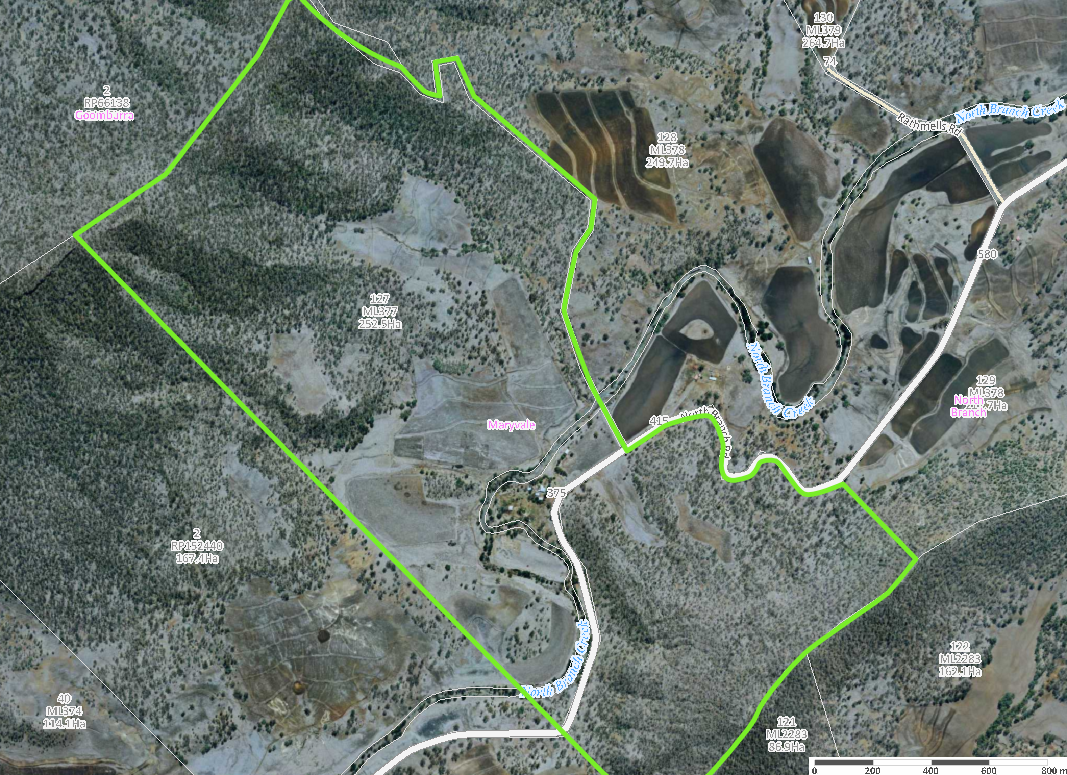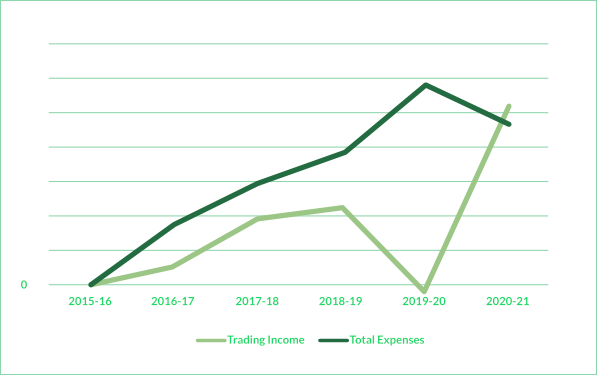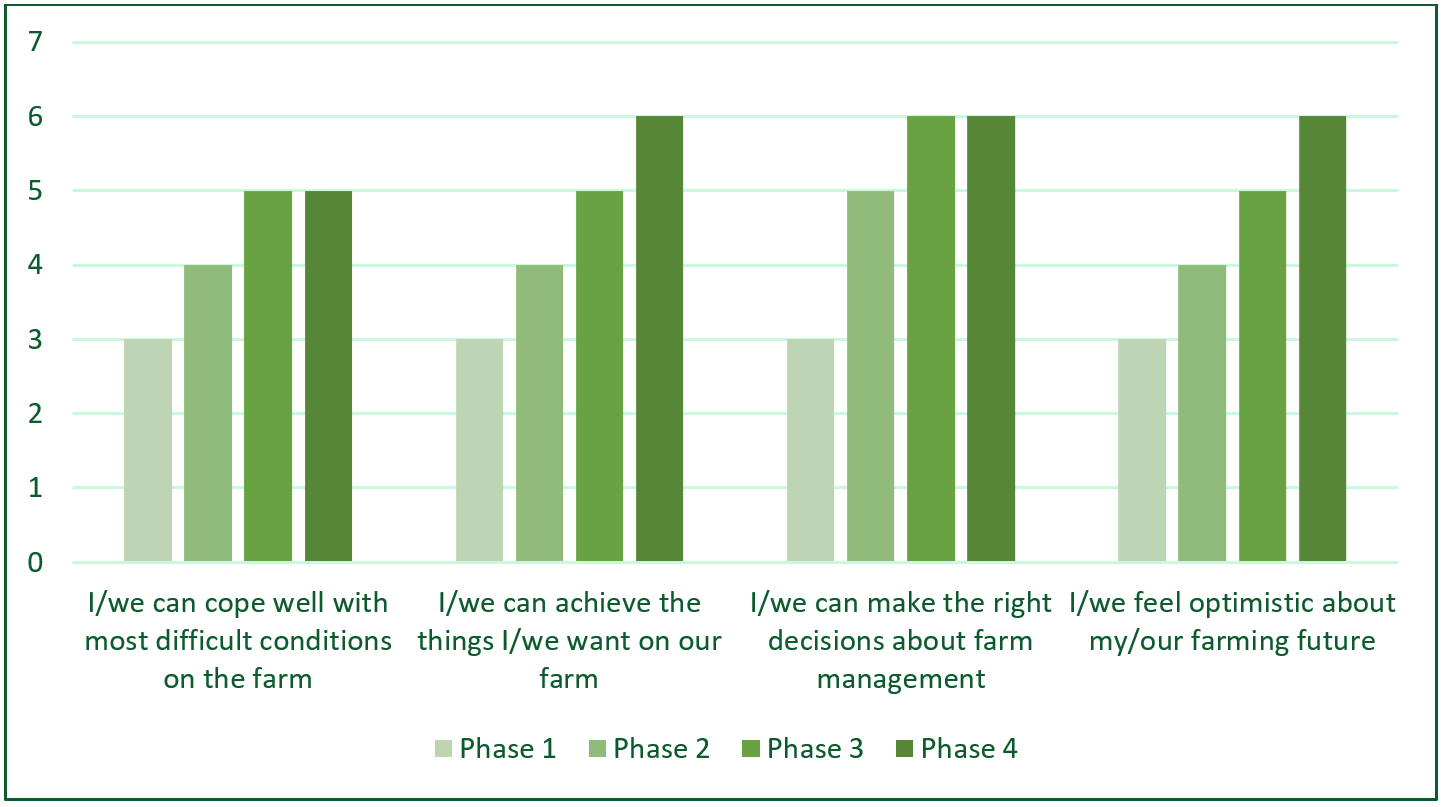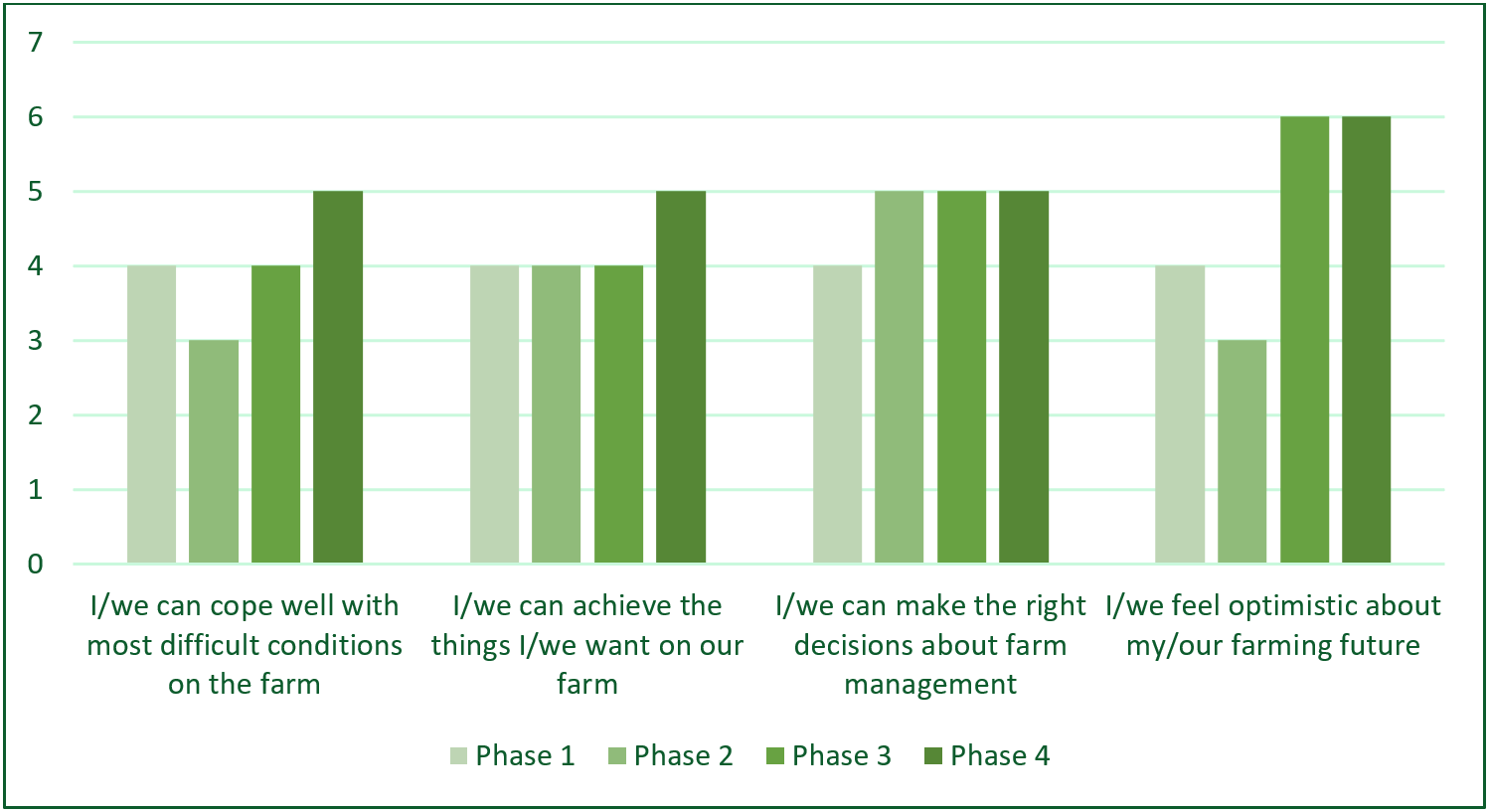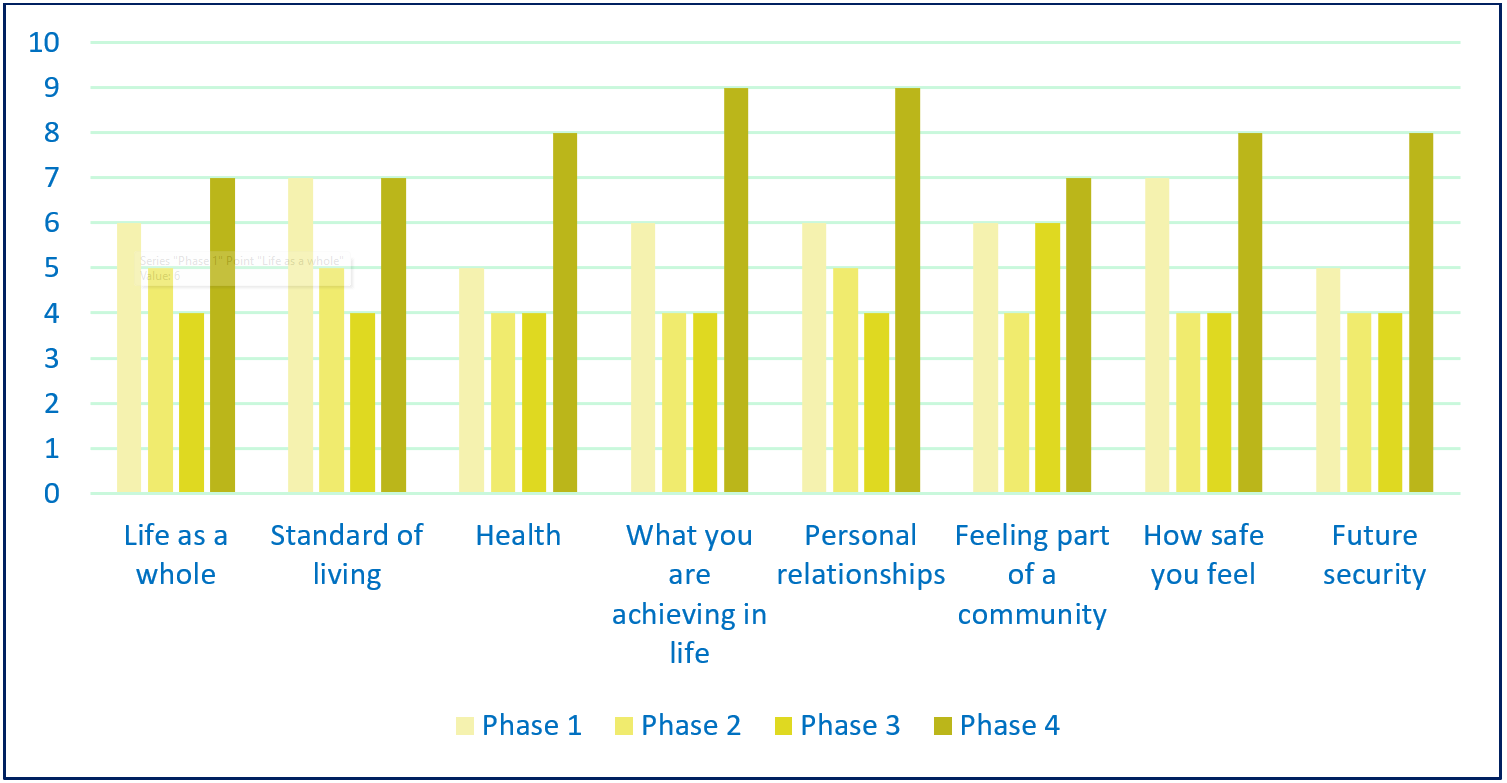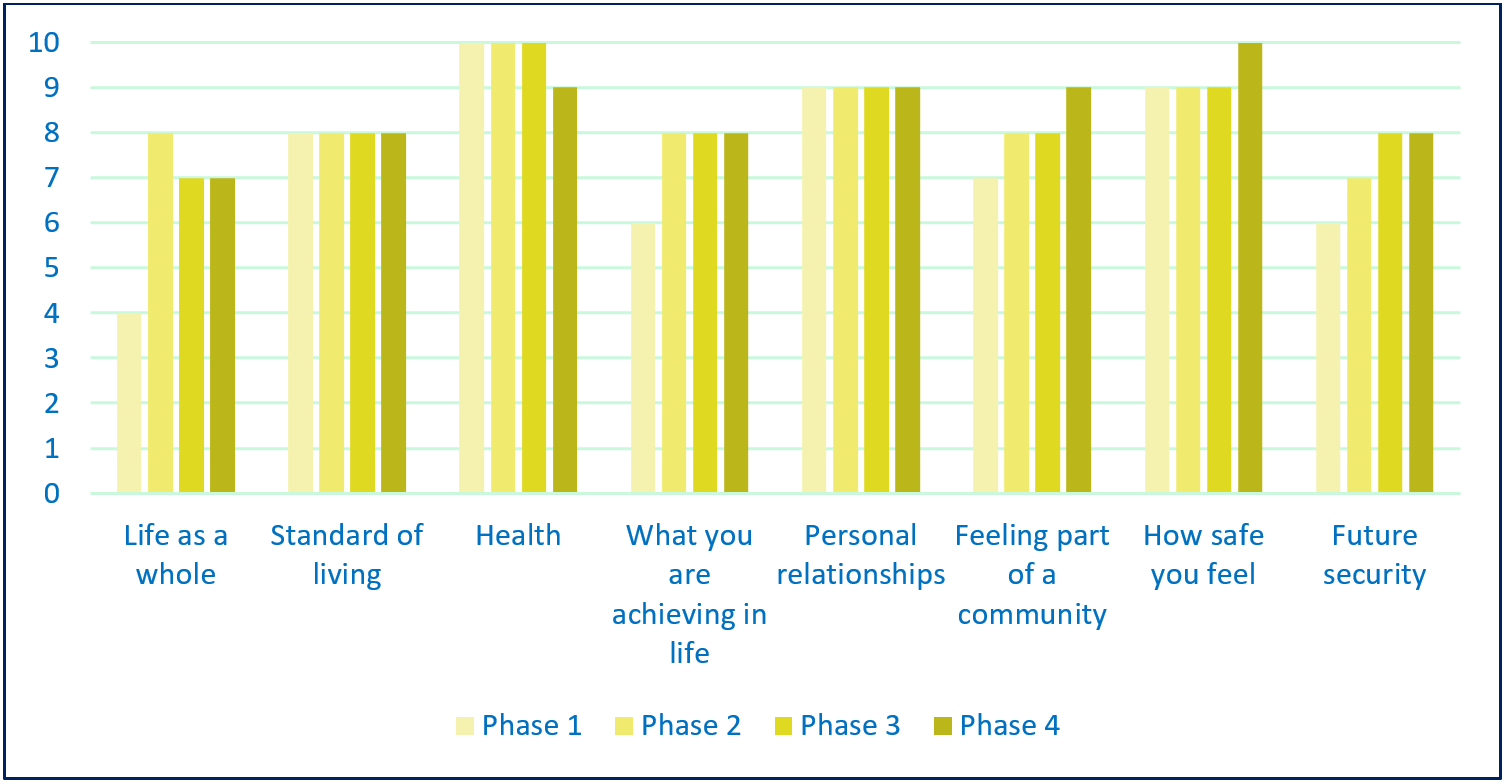"The Morrises at Gleneden"
A NEW FARMER CASE STUDY
Meet Rohan and Fiona Morris. Exposed to the environmental implications of conventional farming on Rohan’s family farm, the benefits of organic farming on their health, and the challenges of accessing fresh food in rural areas, Fiona and Rohan decided to grow their own healthy food for their family and local community.
The first year on their new farm was ‘extremely lush and beautiful’. They started with holistic management planning using organic, intensive, multispecies rotational grazing principles that incorporated pigs, chickens, cattle, goats and then sheep. But in their second year, a devastating drought hit. Rohan and Fiona navigated the drought using holistic management planning (intensive rotational-grazing management techniques), as well as support of their customer community and their close group of regenerative farming families. Towards the end of the drought, Fiona and Rohan introduced Natural Sequence Farming works on their property to rehydrate the landscape, and multispecies pasture cropping to improve herd health; and they are impressed with the effect on their land in the last two years.
It was during the drought, having experienced the challenges of marketing and farmers markets, that they made a successful transition to a Community Supported Agriculture (CSA) model, which was bolstered by their on-farm sales and on-farm camping. They found that once visitors saw the farm, they often asked to join the CSA and were keen to remain connected to the farm.
Looking to the future, Rohan and Fiona are building an abattoir and butchery on their property, as well as seeking to grow their agro-ecological tourism enterprises.
Farm Facts
Location
Annual Rainfall
Agro-climatic region
Property Size
Elevation
Enterprise Type
*Learn more about soil classifications at Soil Science Australia
Location
Githabul Country | Maryvale, QLD
Annual rainfall
750mm
Agro-climatic region
Temperate (Hot summer, cold winter)
Property size
250ha
Elevation
500-800m
Social structure
Owner and operators
Enterprise type
Mixed enterprise beef cattle, dairy cows, sheep, pigs and chickens
Soils
Basaltic uplands black/brown clays
*Learn more about soil classifications at Soil Science Australia
Videos
The Highlights
- Holistic management and intensive grazing of cattle, sheep, pigs, and chickens on pasture
- Off stream, moving water points
- Fencing off of waterways and gullies
- Revegetation of creekbanks
- Organic practices and stock feed
- Growing multi-species pastures without ploughing
- Natural Sequence Farming using swales, leaky dams on gullies and creeks, and creating ‘chains of ponds’ on old drainage ‘contours’
- Reading, reading, reading books
- Attending local farming workshops including Joel Salatin’s Materclasses in 2013
- Completed a Holistic Management Course
- Being part of a Regenerative Farmers support group, made up of six families meeting over the last eight years and grown from a Holistic Management course
- Diversifying farm income with tourism (camping and farm tours)
- Improving cash flow with CSA subscriptions
- Training for business management, digital marketing and book-keeping
- Being part of an active and strategic local Landcare group which offers hands on regenerative agriculture workshops and cultural burning opportunities
- Building organic matter in soils, even in a time of drought
- Fostering reasonable levels of microbial respiration in soil
- Regrowing creek vegetation through fencing of creek lines
- Reversing erosion and rehydrating landscape through Natural Sequence Farming
- Building strong communities of support through a peer-to-peer learning group, with their local Landcare, with their CSA members and with international agricultural programs
The Gleneden story
- Phase 1 - Before owning the farm
- Phase 2 - Buying the farm
- Phase 3 - Surviving the drought
- Phase 4 - Now and into the future
Before owning their own farm
pre-2017
Fiona and Rohan always felt passionate about and connected to nature. Rohan grew up on a farm, and according to Fiona, ‘has the soul of a farmer’. He feels ‘very connected to the land and cared deeply’ about it but his family were conventional graziers. Fiona grew up on the NSW coast and was always interested in the environment, growing food and was passionate that we ‘think more deeply about how we are impacting our [Earth] home’ through our actions.
Gaining insights about access to quality food
Rohan and Fiona met at university, Rohan studying teaching and Fiona ecology and soil science. Rohan’s parents always told him, ‘There’s no future in farming’ and encouraged him to study a profession. But after Fiona and Rohan married, they were drawn back to help manage the family farm. They started producing their own food from their garden, rear cattle, and experimented with raising free-range pigs, while pursuing their professional careers. They spent a few years learning about sustainable farming by attending workshops, extensive reading and research, talking with friends and other farmers, and basic trial and error. But most of the initial advice still came from a conventional perspective.
During this time, living in a rural community, Fiona and Rohan also saw and were affected by poor food quality and availability in their small country town. As Fiona said:
“Living out there, what really frustrated me was the poor quality and expense of fresh food; I learned you must go into the supermarket on a certain day after the trucks come otherwise you get the dregs at the end of the week. It was especially annoying when I realized that locally grown produce was being trucked to the major cities and we were receiving a poorer substitute from those same cities.”
Reflecting on economic realities and impact of chemical exposure
Fiona, then working for a local catchment organisation, had an ‘eye-opening experience’ while working with the local farmers. She realised that often they don’t necessarily want to farm conventionally, but ‘feel that it is their only option to compete’ in the market. She said it was ‘heartbreaking’ hearing many farmers admit that they know their practices aren’t good for the environment and yet at the same time say, ‘I’d like to pass my farm onto my kids in better condition, but I’ve still got to make some money otherwise they won’t have a farm at all.’
Fiona was also increasingly convinced about the need to improve their farm management and especially the need to go organic, after seeing the widespread use of chemicals on local farms. Rohan would have preferred going organic as well, but he thought that his use of chemicals in grazing was fairly minimal, necessary and not a big problem.
However, Rohan reflected on his own chemical exposure when spraying and dipping his bullocks before taking them to a show and began thinking about the implications:
“I would get covered in the stuff, trying to spray them, and then I’d have to dip them and then spray them again. When you have bullocks, you’re yoking and unyoking them, so you’re constantly leaning over the animals you have just sprayed. It’s very easy to spray an animal and then send them on their way, but when you’re that close to the chemicals, you really are much more aware of the impact it has on you.”
Rohan knew his grandfather used many chemicals on the farm and died of cancer later in life. Rohan wondered if the two events were related. He ‘knew in his heart that this was not good for him’.
After staying on the family farm growing their own food for a couple of years, Fiona and Rohan decided they wanted to travel overseas and spend some time learning about other ways of farming.
Learning experientially about organic farming overseas
Rohan and Fiona spent seven months volunteering at organic farms across Japan, Europe and Britain, experiencing first-hand various methods and traditions associated with organic farming.
Fiona and Rohan learned ‘so much’ from the farmers about how to understand and respect natural systems in order to produce delicious food for their families and community in the long-term, without using chemicals. The farmers often had a strong connection to their land, family food traditions and wanted to ‘hand over their farm to their grandchildren’s grandchildren in good condition’.
Fiona and Rohan admired the benefits of a government which supports farmers as stewards as they did in Britain and Europe. In some areas of Europe, farmers are subsidised to live in remote areas, ‘recognising their role in stewarding the landscape’. They also learned how European culture and animals are also tied into this idea of place:
“Their animals are specific to that mountain or valley, which means their cheese is specific to that breed of cow and local native pasture that it eats in that particular valley. It was a really valuable experience, tasting these amazing end products sold on farm or locally. So, when we returned to Australia to the little country town that had old seconds I thought, “Why are we eating so terribly when there are so many local farms producing food?””
Continuing to experiment and educate themselves in Australia
After returning from overseas and back on the family farm, Fiona and Rohan made a concerted effort to transition to organic practices. Fiona believes that having kids was also very helpful in getting rid of chemicals from the farm. ‘I knew that if the kids wandered into the shed… they weren’t going to poison themselves.’
With the goal of producing healthy, delicious food for their family, Fiona and Rohan also purchased sheep in addition to their cattle, pigs and goats, built an orchard and redeveloped the garden. To manage these multiple species, Fiona and Rohan decided to shift to more holistic practices. They undertook additional research and attended courses in holistic management. The holistic management course was an important learning point. It helped them understand the clear connection or balance needed to have good social, economic and environmental outcomes for a successful business:
“[I]t’s important to educate yourself and try to find out as much information as possible. We did a lot of reading about these topics and the regenerative concept was starting about then. And we realised, yes, the holistic management approach we were using was regenerating the landscape to as high a level as possible or at least an intertwined agriculture and ecology concept.”
Fiona’s background in ecology was quite helpful for her to quickly grasp the intention of integrating agriculture and ecology. For two years, she had worked professionally to regenerate creeks after massive flooding in the region. It was during this time that Fiona realised the similarities between her work in ecology and the type of agriculture management they were shifting towards. In this holistic approach, ‘you’re regenerating a landscape by management, in the other, you’re regenerating the landscape by recreating or mimicking the natural system: ‘it’s the same thing, which is you let nature regenerate itself. So then suddenly, it just clicked’.
The ‘real epiphany’: integrated grazing; mimicking nature
But the ‘real epiphany’ for them occurred while doing a three-day masterclass with Joel Salatin on running beef, chickens and pig enterprises. Joel talked about agriculture in terms of ‘working in a system as close to natural as possible’, and ‘using nature’s abundance of light and water’ to create healthy animals and landscapes.’ The clincher was that Joel Salatin explained how this could be done viably as a farming business. Fiona and Rohan ‘turned to each other and said, ‘Well, that’s easy. We just need to shift this animal here and that animal there and this animal here and we’re done’. They had all the elements and felt that the integration of these different animals was necessary but they ‘hadn’t quite designed it properly’ yet.
Another important part of attending these workshops was meeting other like-minded farmers. Rohan and Fiona visited the friends they had met at the workshop to look at their system set-ups. Based on these visits, Fiona and Rohan bought nets, re-arranged their processes, and ‘were off racing within three weeks’. They believe that their fast transition was helped by, firstly being open to and seeing new methods and secondly, having a goal to improve landscape – recognising ‘this actually creates a better product’. As Fiona says:
“You can’t make a silk purse out of sow’s ear. If you want to have a good end product, you need to start with a good system – healthy soil creates healthy plants, healthy animals and healthy humans. And you’re rewarded because the food tastes fantastic and the landscape looks beautiful.”
Time to build confidence
Fiona and Rohan feel very lucky to have been able to practice for five or six years on the family farm, rent-free and without the pressure of having to start a business while they were working off farm. During these years, they could continually tweak their multispecies grazing systems and build their customer base. They also joined a peer-to-peer support group that developed out of one of their holistic management courses. They started selling products from their enterprises to the local community and started believing that a direct selling farm business would be feasible for them.
Deciding to create their own farm
However, despite their best efforts with grazing management, waterway improvements and tree planting, they felt the past management of the farm and neighbouring farms had made their situation to improve the soil very challenging. They could see significant improvements in many paddocks but on a large area of the farm: ‘the soil was sodic subsoil, it was just terrible, and it was heartbreaking that whatever we did was not going to fix it for a long-long time.’ The farm also had significant salinity problems caused by practices across the catchment, which they couldn’t change. It was also too small an area to be profitable enough for them to be full time farmers. So, Rohan and Fiona looked for a location where they could expand.
Buying the farm and getting set up
2017
Selecting the right property
Using their holistic decision making, Rohan and Fiona (and now their children Eden and Jethro), decided on several criteria for their property. They wanted enough land to expand their enterprises; it needed to be close to a population centre to operate a direct selling business; it needed to have remnant vegetation, good soil and good water; be near family; and they wanted to find a place that wasn’t affected by aerial chemical application. Easy.
In the foothills of the Main Range of the Southern Downs Region in Queensland, they found an ex-dairy farm that met these criteria. In addition, a third of the property was undulating native pasture and woodland in reasonably good condition although the productive flats had been overgrazed. Their hope was that the ‘nutrients and native species on these hills will flow back down’ to regenerate the landscape, so ‘regeneration felt like it was a lot more possible in our lifetime. The elements to recreate a more natural system were there’. Buying land as a new farming family is challenging with land prices. The Morrises consider themselves fortunate to have partnered with family to invest in the property, with the plan to pay them back as the business allowed.
The previous landscape
Gleneden is situated on Githabul Country. After the First Nations people were displaced, the land was used for grazing and later converted to a dairy farm with intensive use of the more productive alluvial flats. Following significant erosion events on the very dispersive black soils in the 1970s, the government subsidised the construction of contours, to hold the soil following ploughing. Unfortunately, this ‘European method was not congruent with the context of this landscape’, effectively draining the water off the landscape and causing severe gully erosion at the end of each ‘contour’. The dairy farm was then converted to a cattle stud and hay/fodder production farm. A lot of ‘extraction was happening, the biomass was taken, and not much was put back, aside from fertiliser.’
When the Morrises bought the farm, there were signs of landscape degradation. The pastures, though green from recent applications of nitrogen, were compacted and roughly a metre of topsoil loss on the slopes was visible on the edges of the cropping paddocks. The creek was eroded, and the paddocks overgrazed as the cattle freely roamed the lower flats.
Starting with soil: sampling the baseline
One of their primary goals was to operate an organic farm, so Fiona and Rohan had to prove that the soil was free from heavy metals and organic phosphates. Having studied soil science, Fiona was interested in about the soil testing process and wanted to know the overall quality of the soil they had to work with. With limited funds, she selected three locations of surface soil (zero to 10cm) on the more intensely used paddocks and took representative samples, ‘as you walk, you take several soil samples from the top 10cm and mix them together in a bucket, then take out a handful to test. This gives you a general sense of the paddock you took that sample from.’
The fourth test was a ‘control’ test in the natural remnant woodland, a subject close to Fiona’s heart. Fiona had observed how typically, a control is conducted in ‘a paddock next to experiments’ to show the changes in ‘the context of the farming area’. But Fiona ‘really wanted to know the carbon levels in the forest’ because ‘if you want to get as close to mimicking natural processes as possible, what better information than what is in the natural process?’ She took representative samples about 100 metres into the foothills of the woodland (in order to avoid an ‘edge effect’).[1]
The results from the three paddock tests, though limited, indicated that there were no chemicals and heavy metals in the soil, ‘which was great’. The control test of the forested areas showed 6% carbon, which is higher than most agricultural areas, but not as high as Fiona expected. The samples also provided an indication of total available nutrients so the Morrises could determine a baseline and find out what the soils were deficient in.
[1] In ecology, ‘edge effects’ are changes in population or community structures that occur at the boundary of two or more habitats.
Setting up intensive, multi-species, rotational grazing
A ‘driving force’ for Gleneden Family Farm was to have quality produce for ‘our family and community, and therefore we needed diversity in what we produced’. This worked well in their holistic farming plan as they recognize that ‘diversity (of species) is also the key in nature; different animals eat differently and use their landscape differently.’ As such, Fiona and Rohan brought their ‘menagerie’ with them to the new farm – their breeding pigs, chickens, goats, ducks and cows. Developing a flexible approach for intensive, multispecies, rotational grazing – to mimic the animal diversity in a natural ecosystem – was important to them.
The first action Rohan undertook was to ‘walk up and down the creek and through all the paddocks to shut the gates’ to protect the water ways and manage their animals in a rotational grazing system. In addition to the existing permanent fences, Rohan set up a flexible and responsive system of fencing and waterpoints to managing their intensive, rotational grazing (Table 1).
Table 1. Fencing types and their purpose in enabling intensive, multi-species cell grazing on Gleneden.
| Fence type | Purpose |
| Steel post with steel single or double hot wires |
Permanent paddock perimeter, where straight fences are suitable in the landscape Wildlife friendly and quick to install Water pipe is placed under the permanent fences with an occasional tap to connect water troughs Good for cattle management (in order to integrate sheep and pigs later, he’ll add a third hot wire) |
| Steel post with single aluminium hot wire |
Semi-permanent around new paddock perimeters, paddocks with bends, around slopes to reduce tracking erosion, around gullies and sensitive areas. Wire is light, quick and easy to build Water pipe is placed under the fences with an occasional tap for water trough Is responsive to undulations in the landscape Good for cattle |
| Electric tape with tread-ins |
Very flexible, moved every 1-3 days in ladder fencing between more permanent fences. Allows for very responsive paddock size depending on herd, season and landscape conditions. Connected to mains or using energiser connected to battery and solar panel. Good for cattle |
| Electric netting |
Very flexible, Moved every 2 – 4 days for chickens, pigs, sheep Protects chicken and sheep from wild dogs, foxes, cats (their cattle have horns, so are able to protect from wild dogs) Manages pig impact on landscape (keeps them contained) Good for sheep, pigs, chickens. Connected to main electrical fence or using energiser connected to battery and solar panel. High labour component – investigating adding hotwires to semipermanent fencing (though this exposes lambs to predation) |
As the majority of the fencing system is non-permanent, and the animals are moved often, a flexible water system was required. The Morrises run polypipe from three permanent tanks across their property. Portable water troughs, which are moved with each herd (or flock) are then connected to the nearest tap in the polypipe. The tanks are supplied from a bore and creek water using a solar pump (electric backup). This approach of flexible watering points is distinct from approaches that install permanent water troughs. While more time intensive, this approach allows for greater flexibility with their paddock placement and reduces the traditional compaction around water points.
Using this fencing and watering system, Rohan and Fiona were able to implement their intensive grazing plan. The herd movements and durations respond to the seasons, weather, and needs of the landscapes and animals. On average, Rohan moves the cattle and sheep every one to three days, and the chickens and pigs every one to two weeks.
Their holistic approach is about ‘being flexible to conditions’ and ‘moving the animals before they over impact the landscape depending on the outcome you want to achieve’. Instead of using a ‘recipe of X many days, X many head, moved here, here, here and here’ it is an active process of always questioning ‘Why am I moving? What am I trying to achieve?’ based on the unique conditions. For example:
“In spring we will have larger paddocks for the cattle to move through quicky. We just want them to tip the pasture because everything’s trying to grow. If we go in there and intensively hit everything, you are jolting the system when it’s just starting to pick up. So, we open up the paddocks a bit bigger. As a season goes, we might start making them smaller and smaller to allow the paddocks you are not using to regenerate. The key here is that your fencing and water is movable.”
Getting started financially: experimenting with different markets
In transitioning to the new farm, the Morrises’ goal was to start selling their organic produce as quickly as possible. Unfortunately, during the move they had to sell their steers because crossing jurisdictions meant they had to dip their cattle and the steers would no longer be ‘organic’. The cows’ progeny born on the new farm, however, could be classified organic but this would take time. For immediate cash flow, they set up the breeding pigs and sheep, and purchased local organic cattle. They also agisted cattle which they quarantined then managed organically.
Even though Fiona and Rohan previously had a chance to experiment with sales on the family farm, in this first year, they had a steep learning curve about the financial realities of (re)starting a business:
“Yes, you’re managing a farm regeneratively, organically, or holistically, but you’re still running a business. And you’re going to fail running that business if the business is not financially viable, and that’s just the way it is. Understanding marketing and your customer’s wants and needs is vital. And I didn’t know much about that when I started the business. I had no idea. I was thinking, “I’m going to be such a good farmer. Everyone’s going to love the food.” It doesn’t work that way.”
Setting up the meat sales was ‘really hard’ initially, as most people in their local farming community thought organic meat was ‘a luxury’, and yet ‘people will go into the supermarket and pay $30 per kilo for steak, but do not want to pay a local organic farmer $25 per kilo’. Learning how to market their produce and sell directly was a challenge.
Initially, Fiona and Rohan started developing a small customer base selling meat boxes and cuts at the local markets but visiting the markets once a week was ‘draining and wasn’t earning enough.’ They then began on-farm sales to visitors and campers. In fact, most of their first customers were campers. Once people ‘came to the farm and said “wow, those animals look happy”, they’d buy the product, taste the difference, and keep asking for more’.
In addition to the benefits of sales, Fiona feels an open farm keeps them honest and ‘on their toes’. People can drop in on the farm at any moment, but they find the visitors very useful. It keeps them asking ‘Would I be happy for anyone to see this right now? And if the answer is no, we fix it. It doesn’t mean that things don’t go wrong, it is a farm, they always go wrong, but it’s about maintaining a high standard and being honest with people’ about the realities of farming.
Surviving the drought
2018 - 2020
The first year on the farm in 2017 was ‘extremely lush and beautiful’. But, after their first year, a severe drought hit, lasting for the next three years.
Initial responses and building enterprise resilience
A quick drought responsive action was to destock and get rid of the agisted cattle. This response essentially halved their stock, but also impacted their cash flow. They then planned their grazing using holistic management principles and, in the end, like many, also had to sell most of their own cattle, meaning they had less products to sell, which impacted their cash flow.
Rohan undertook a very precise rotation with the remaining cattle and sheep in increasingly smaller and smaller patches to allow the remainder of the landscape time to regenerate. He had to calculate how much the animals would need and how much the paddocks could afford to give up for the shortfall.
Fiona was surprised to see that ‘even if you take the cattle off, the heat and the dryness and the brittleness of the landscape is so intense that after a certain amount of years, the pasture actually dissolved and disappeared. It’s not that it’s over-grazed, it didn’t even have animals on it, it just turned to dust.’ Over time with worsening conditions, the paddocks got to the point where ‘there’s nothing there’.
They were fortunately able to source vegetable scraps from a local organic packing company for the sheep, but Rohan and Fiona struggled to find and pay for organic feed for their pigs as national grain supplies dwindled. In 2018, they did their own research on other ways to feed pigs organically, and devised plans to reduce the pigs’ feed requirements by increasing the availability of forage over time . They gathered advice from regenerative agroecologists about multispecies plant mixes for pig and soil health. After the pigs grazed a paddock, the Morrises would cast the seed mixes and put on sprinklers. Eventually, when the rain returned, they were able to reduce pig feed by half, improving their cash flow.
In the last three months of the drought, the Morrises ran out of pasture and water, with a significant impact on business cash flow. They decided to reach out for help to both sink another bore and to remain committed to their organic goals by buying organic hay. With the help of family, customers, friends and government assistance they were able to water their remaining stock and ‘feed’ out hay to their remaining animals. ‘It’s truly humbling to have to ask for help, but the response was amazing, and we are forever grateful’, says Fiona.
Rohan and Fiona decided to ‘feed out’ the hay to the cattle and sheep in small ‘sacrifice’ paddocks. This was a technique suggested by Dick Richardson, a hoslistic grazing consultant. The idea being to minimize impact on the rest of the landscape. It also meant that the animals concentrated their urine and excrement in this area and that mixed with the wasted hay underfoot, feeding the soil.
But as ‘horrible’ as the drought was, Fiona tried to keep positive, telling herself, ‘This is the worst it’s ever going to be for a long time, I hope.’ And looking back, the drought provided them with ‘a really good understanding of the carrying capacity in extreme times and the need to rehydrate the landscape.’
Securing cash flow in the drought
During the drought, Fiona and Rohan, were extremely busy feeding stock, and they knew they had to:
“Find a better way of marketing that didn’t involve us going to a market once a week or putting brochures around which didn’t work. And newspaper marketing didn’t work. All those traditional marketing concepts don’t work for a small farm on a small budget.”
Fiona and Rohan had been speaking with Tammi Jonas, president of the Australian Food Sovereignty Alliance, about the CSA concept, and with motivation from their farming support network, the Morrises began offering CSA subscriptions of a mixed box of beef, pork, and lamb. Being self-described as ‘less gregarious’, Fiona believes the CSA model and the one-on-one relationships it affords with their customers, also suits them better than the crowd-heavy farmers market model.
The CSA subscriptions grew very quickly, through word of mouth and from campers visiting the farm. The Morrises also started offering free camping and farm tours to the CSA members, which their members love: ‘they start to feel like it’s their farm.’ Fiona attributes the success of the CSA approach to the ‘personal relationship’:
“When you’re looking someone in the eye, they can see that you’re telling the truth and they can see the evidence right in front of them, and they’ve tasted that evidence. And also, you need to offer your product in a way that’s convenient for them. Once they see how the farm is run and how content the animals are they say, “Great, if you’re going to deliver me this amazing meat and I know exactly where it comes from, and I know what’s not in it, sign me up!” People buy our produce because they like us and what we do, and obviously, they like the meat.”
Since transitioning to the CSA model, they have been ‘pretty much sold out ever since and don’t have to actively advertise anymore, which means all of the energy we would have put into marketing or going to the markets, we can put into being better farmers.’ They also continued to diversify their enterprises and income streams by offering camping, educational farm tours and heritage shows with their bullock team:
“Diversifying our income is really important because when you are changing or starting a farming enterprise not only do you have to suddenly be a business management pro, an amazing farmer, you need enough money coming in to pay a significant mortgage due to high land prices, which is really expensive for people newly entering the market. It’s very hard to do that just on a farmer’s wage, which is one of the reasons people don’t just start farming.”
The CSA also helped build resilience on the farm in other ways. During the drought, the time came when there was no water in the creek or the bore. And Rohan said to Fiona, ‘we’re done, if we can’t get water for the stock to drink’. Not wanting to give up on their dream, Fiona suggested they put out a call to their CSA members and local community for funds for hay and a new bore in exchange for camping and tour vouchers. They raised $15,000, and the government subsidised the other half. Fiona reflected, ‘we were too shy to ask unless we were absolutely desperate! So having a community that were connected to the farm and cared about it (and us) was hugely important.’
Building resilience through landscape rehydration
The drought was very difficult for the business and their earnings suffered, but ultimately their responses to the drought helped the Morrises’ business survive. And, looking ahead, they also wanted to ensure their landscape was more resilient in the face of the next drought.
During the drought, their local Condamine Headwaters Landcare group secured funding to run a Tarwyn Park Training Natural Sequence Farming workshop, followed by on ground financial assistance to local farmers who attended the workshop training. The Morrises hosted the training workshop which was presented by Peter and Stuart Andrews and their team and later applied for funding to do several Natural Sequence Farming projects.
One of the rehydration improvements for the Gleneden Farm was to block the drainage of the roughly 15 pre-existing contours constructed in the 1970s. During the workshop, Peter Andrews explained how the ‘old fashioned contour drains’ on slopes had been designed to trap sediment and water washing down the slope from ploughing. However, these ‘contour drains’ ended up concentrating water from the landscape and created large erosion washouts where the water flowed into the gullies. Peter demonstrated a low cost, easy method of repurposing these old contour drains into water retaining dams so water could infiltrate into the landscape and reduce further erosion.
During the workshop, they also learned about the Natural Sequence Farming strategy of installing swales along the contour to distribute, not concentrate, flows over the landscape. Ideally these swales are constructed at the highest level of the property that is practical. While initially hesitant about adding more manmade changes to the environment, Fiona was ‘impressed that you don’t need to create much disturbance to make a difference.’ The contour bank is, only one foot high in some places which is ‘just enough to slow and distribute the flow.’
To create a swale, the Andrews and Morrises chose a location near the highest accessible point of their property. This happened to be on the same level as a small existing dam. The 10m wide dam had been constructed in a gully, and never actually held water very well. As part of the Natural Sequence Farming measures, swales were built that extended from the dam on either side, creating a level bank as wide as practical. Now, as water flows downs the gully ‘the water is gently spread and dispersed across a much greater distance along this swale, rather than being forced into a small catching area, where the energy pressure of water during a rain event could blow it out’.
Another Natural Sequence Farming technique used by the Morrises is to build ‘leaky weirs’ along their creek. Before clearing and overgrazing on the creek, a storm would cause trees and shrubs to fall into the creek and ‘catch sediment and debris’. However, since settlement, ‘we’ve changed the riverbanks by taking away the vegetation, so this natural process doesn’t happen; nothing now stops the flow, and the energy just keeps scouring the riverbank.’ The Morrises built their leaky weirs, using rocks and water plants, in strategic locations along the creek as they were shown during the workshop. Again, this did not require much intervention. In some cases, the rocks are only a foot high and water can still flow though and over them. It has made a difference though, slowing the flow, encouraging more water plants to grow and holding the water longer. Rohan and Fiona have fenced off the creek from the cattle (sheep and pigs) and only graze when the weed load is high. This has allowed the creekbanks to regenerate, naturally holding the banks, and the water.
Active members of the local Landcare group
The Morrises are active members of the Condamine Headwaters Landcare Group, and have helped run and hosted workshops. Their Landcare group has recently received funding to hold regenerative farming workshops to connect local regenerative farmers and visit farms so they can see and discuss practical questions, such as ‘how’ to regenerate the landscape: ‘What seeds do we plant? Where do we get the seeds from? How do we build the fences? Where do we get the equipment from? How is it going to impact on our bottom line? Can we make no till farming work if I can’t afford a slasher?’ Fiona says:
“I’m really proud of our local Landcare group. They help fill the gap that extension services used to provide. They offer workshops, field days and have even considered things like purchasing equipment that people can use to improve their management. They have just purchased a laser level that people can use to make contours as part of the Natural Sequence Farming projects. That’s really helpful because smaller farmers especially, can’t afford to buy all these bits of equipment when they only use them occasionally. I know that I might need to go out and mulch my paddocks, but I can’t afford a $40,000 mulcher. So, this sharing of equipment could be a really powerful idea.”
The Landcare group is also building a connection with the local Githabul people. Through mentoring with Victor Steffensen, co-founder of Firesticks Alliance Indigenous Corporation, the Githabul have been offering cultural burning techniques to landholders in the region for several years. For the workshops the Githabul people, trained by Victor, go to a range of local properties and show the landholders the benefits in their techniques for cool burns, which are gentle on the soil, reducing the weeds and stimulating native regeneration. Fiona and Rohan held a workshop on their property, and found it to be a powerful experience:
“We had one of the Fire workshops on our place and it was really humbling and beautiful the way that the Githabul people understood the landscape and were so connected to it, and caring about it, and willing to share their knowledge. They just honestly wanted to say, “Look, we’re happy with you managing it, but you need to do a better job.” My son who was eight at the time, also came along to the workshop and it was amazing how quickly he picked up the teaching (law), sometimes kids are more open to new ideas and he was just so excited to be included. The Githabul people were so patient with him, quietly teaching him about respecting the landscape.”
Now and into the future
2022
Since surviving the drought, which broke in late 2020, the Morrises have had time think ahead and plan for their next steps in terms of production, soil, ecology, and their own approach to farming.
Production: Value adding – Plans to build own abattoir
Rohan and Fiona with the help of a CSA member have designed their own abattoir facility, including a butcher shop, kitchen and farm shop building. They have now received a grant to implement the design. For them, the ethics of caring for animals are central to their practice, and ‘having to send them [the animals] offsite because of legalities to be butchered is heartbreaking’:
“Fortunately, there’s a recognition that farms need to diversify to become more resilient and we have applied to a grant from the Queensland Farmers Federation to build our own abattoir. We want to be able to have a process that is more ethical for the animals, a true paddock to plate. The animals will be slaughtered and butchered all on farm without going through a stressful off farm process. We would also have more quality control, and flexibility over the cuts and flavours of what we produce. We’d also be able to start doing educational paddock-to-plate workshops, which is something that I really enjoy.”
Soil: Strategic monitoring
Fiona has many questions about their soil and is keen to continue soil testing. Ideally, she’d like to test for available and total nutrients, micronutrients, soil biology and soil carbon across the different parts of the landscape. Their total phosphorus on the farm is pretty good, but the available phosphorus is low, so her questions, for example, are: Why is there such a big difference and is there any relationship with the biological activity? What is the pattern of available carbon and nutrients over time using the holistic planning grazing? And how can we increase their upward trend?
Ecological: Introducing more native vegetation
The Morrises plan to continue ‘mimicking and intertwining nature into their production system’. The next step is to grow a five to ten metre-wide buffer of native vegetation from the local species in the area on the old contour banks which they have turned into a chain of ponds, including eucalypts and shrubs from seeds gathered further up in the forest.
The intention for this native buffer is to ‘increase biodiversity, water absorption, biomass, humus and nutrient levels, which improves the soil and also ultimately feeds the grass and their animals, while also providing them shelter’. On their flats, it’s ‘boiling’ in mid-summer and ‘freezing’ in winter, so Rohan and Fiona often take the animals into the forested areas in the height of summer and winter but having these tree layers will increase their space and flexibility for the intensive grazing.
Government: strengthening the partnership with local government
When the Morrises first moved onto their property, they initially met with local government to discuss value-adding options such as farm tours, camping and butcher shop/kitchen facilities. The council was initially supportive, but then Fiona and Rohan experienced challenges in getting final approvals for these new small scale agritourism style enterprises.
When exploring where to purchase a property for diverse regenerative enterprises, Fiona and Rohan found the language of the zoning rules significant. As Fiona said, ‘If the council regulations only list what can happen in a certain zone there is no room to move if your activity is not on that list, even if it’s aligned with an agricultural activity (e.g. a farm shop) and would have a minimal impact. We just hadn’t thought about it when the regulations were written. This effectively limits your options straight out.’
Fiona hopes to see state and local governments coordinate policies to be in better alignment with small-scale regenerative style farming and agritourism. She’s interested in finding ways to open dialogue with local government to recognise the benefit of small-scale low intensity farms to the community. By working with local councils, she believes these enterprises would feel less risky to government, and scalable regulation could be introduced. She believes this would ‘have a huge impact’ on rural communities and family farms: ‘Instead of having big farms with a few employees, you’ll have much more viable, smaller farms with greater diversity of enterprises.’
More recently, their local government is taking interest in regenerative farming and seeing the opportunity for building tourism. The local government is sending Fiona and Rohan on a tour to Tasmania to learn about agro-food tourism and bring back these lessons to the Southern Downs.
Social: keep learning and adapting approaches
Fiona and Rohan will continue to be open-minded and learn about new farming approaches that align with their ethics. Right now, they might lean the most on holistic management philosophy because ‘the core of that is understanding what you’re trying to do in context, balancing social, environmental and financial sustainability’, but they also integrate aspects of biodynamics, Natural Sequence Farming, permaculture and Joel Salatin’s work, because ‘no one farming philosophy or farmer is perfect’. If you ‘lock yourself into purely following the certain concepts, you miss the beauty of the other ones’. Fiona reiterates that it’s not an instant transition to a different style of farming. Rather, ‘it’s a history of pulling in all these different parts of your knowledge base and tying them together to see what fits into your business and core values.’
Working Towards Holistic Outcomes
Find out more about the practical and scientific information around the outcomes to which the Morris family at Gleneden are working towards.
In this section, we present the changes that Fiona and Rohan have observed over time, as well as changes explored in this case study process, in relation to ecological, soil, financial and social outcomes of their farming philosophy and practices.
ECOLOGICAL
Ecological Changes
The interconnectedness between the solar energy cycle (capturing solar energy in plants) and water cycles is evident in the outcomes of the Natural Sequence Farming on Gleneden. The influence of the Natural Sequence Farming swales can be seen in the increased density of ground cover and biomass below the contour lines. After the rain in March 2022, Fiona observed how very effective the contour ponds are.
“And I’m so glad they’re there. Especially after this rain, because all that water would’ve left the farm, gone screaming down the gullies that they were directed towards, which has already caused significant erosion issues into the washouts, into the gullies, screaming down the gully, ripping all the sides of the gully out and then screaming down the creek and ripping that out. So hopefully now it’s infiltrating and going laterally through the systems slowly, which is how you rehydrate it. I must admit, I was a bit skeptical, because I’m very cautious [about] interfering in nature. There’s always an equal and opposite reaction to what you’ve just done. But I am not skeptical any more after seeing it working so effectively.”
The Morrises have also observed changes of their leaky weirs. ‘I was surprised that a couple of rocks, less than a foot high, can make a massive difference. You’re not filling and creating a dam wall. You’re putting a couple of rocks here and there. And the difference is amazing. You can actually lift the height of the creek by half a foot with just half a foot of rock.’
The impact of fencing the creek line and the leaky weirs can be seen in the comparative photos below (Image 1). According to Rohan:
“Without cattle chewing them every day, the young casuarina trees have been able to grow and will soon make up for the bigger trees we lost in the 2019 drought. These trees and many other types of plants are growing and thriving all up and down our creek now, stabilising the banks and filtering the water. We hope that one day a family of platypuses might decide our creek can be their healthy home again. The last reported sighting was in 1954.”
The sheer volume of biomass has increased along the creek, the Morrises have seen fish return, and witnessed a greater variety of bird species, including the famous Reed Warbler. The daughter of the previous owner visited the farm and couldn’t recognise the creek due to the regrowth around the creeks.
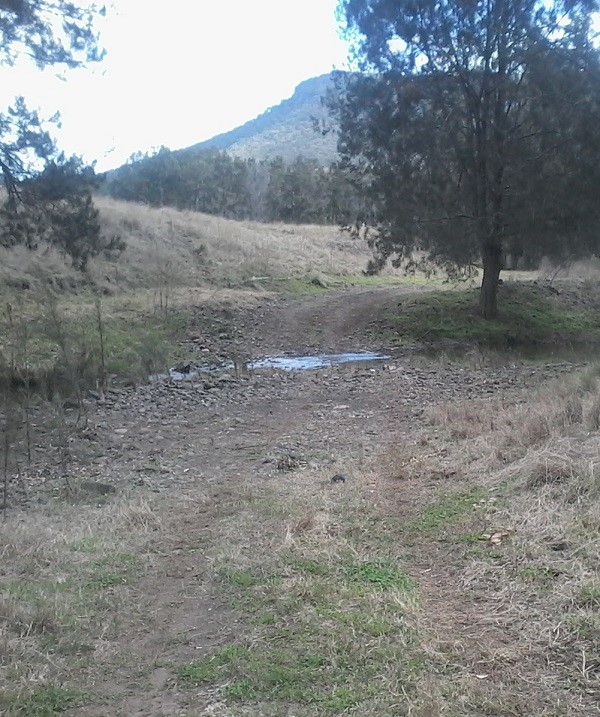
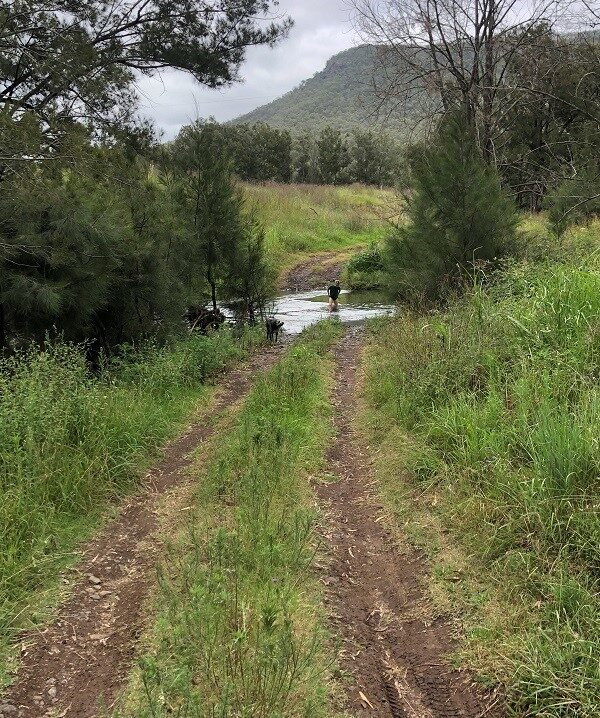
Image 1. Creek crossing, in winter 2016 (left) and summer 2022 (right).
SOIL
The soil food web
The soil food web, or soil microbiome, is the major functional structure builder of soil. Bacteria build the microaggregates, whilst fungi are essential for the macroaggregates.
The best way to support functionality of the soil microbiome is to ensure living plants and maximum ground cover throughout the year. These practices are management priorities for the Morrises.
The soils at Gleneden
Soils for Life undertook soil monitoring in late May 2022 on Gleneden Family Farm (Figure 2). We also had access to the Environmental Analysis Laboratory (EAL) soil test results from late 2017 just as the Morrises were entering a period of significant drought in their region. Two zones were sampled during both periods: the woodlands (upper western third of property) and the creek flats (middle third of property). The woodland and creek flat zones are representative of the two main soil types for the Gleneden property according to the Atlas of Australian Soils (Figure 3). The woodlands in the steep hilly regions have dark shallow porous clay loam, whilst the other sites with soil samples taken (e.g. creek flats, eastern contours and dairy flat) are in the gently sloping dark cracking clay region.
From the pre and post drought samples we can see that perhaps the lighter of the soils in the woodlands have lost some of their organic matter reserves, whilst the heavier clay soils have maintained theirs.
These organic matter outcomes are a combination of the landscape functions themselves as well as the holistic management strategies that were employed during the extended drought period. The Morrises; strategic use of stacked animal impact (pigs, cattle, sheep), cover crops, as well as feeding animals organic hay, and organic vegetable wastes accessed from nearby markets, in a ‘sacrifice paddock’ contributed to improved organic matter. In addition, the heavier soils have an inherent ability to hold more nutrients and water in profile (due to higher clay content, organic matter levels and depth of soil profile), which also contributed to the better-than-maintenance status of organic matter and biological activities seen with the soil tests.
Figure 2. Satellite image of Gleneden Family Farm (lot number 127 ML377 outlined in green; (Source: Southern Down Regional Council Intra-maps, 2022).
Figure 3. Gleneden soil types (Source: Atlas of Australian Soils, 2022).
Practices and outcomes at Gleneden
The implementation of Natural Sequence Farming principles to restore the hydrological cycles of their landscape are having a positive effect from visual functional improvements in the landscape and also the soil functionality and biological results.
Whilst there weren’t any biological tests done prior to the drought, the improved availability of phosphorus, calcium and zinc, especially in the creek flats, indicates that the food web’s functional capacity has grown, especially that of the fungi and nitrogen dynamics. Practices influencing these improvements are the contributions to the system where pigs, sheep, cattle and cover crops were utilised, as distinct to another paddock where fertiliser, cover crop and only sheep and cattle where grazed (see Gleneden Soil Report for more details on these experiments and results). The latter site had less legumes, and greater weediness to the area, indicators of an unbalanced bacteria and fungi community (e.g. a more highly bacterial nature) and compaction layer 10-15cm of these soils.
The Haney tests indicated good Soil Health Scores and high microbial respiration rates. These positive outcomes are due to the significant proportions of the organic matter present (e.g. for microbial feeding) as indicated by organic carbon and organic nitrogen levels. Another encouraging result of their management practices is that the majority of the soils’ nitrogen is in the stable form of organic nitrogen.
In general, the soil tests showed good soil functionality, but in terms of improvements, the organic carbon to organic nitrogen balance needs a little tweaking in some sites, and increased nematode activities are needed. These changes would incrementally grow the healthy soil system, improve nutrient cycling, and thus, over time help support all soil processes to create the greatest efficiency possible in soil system functionality.
- Increasing animal impact with smaller management areas
- Lifting diversity of animals
- Increasing diversity of plant species through designs that include various plant families and canopy heights
- Seed dressings (including bio-stimulants)
- Foliar sprays with the limited available micronutrients boron, molybdenum and copper
ECONOMIC
Economic changes
Since drought broke in 2020/21, the labour-adjusted Earnings Before Interest and Tax (EBIT) was the highest it has been since they started the business. If excluding owner operator labour allowance, Gleneden has made a small positive EBIT in 2020/21, and Fiona and Rohan feel the current financial year (2021/22) continues this trend.
Gleneden’s current business model is a regenerative farm, with income streams from tourism (camping, farm tours, bullock team) and CSA subscriptions for their beef, pork and lamb. The financial analysis of Gleneden was based on these enterprises and, in sum, found that Gleneden was severely impacted by the drought and COVID-19 pandemic, but after five years is becoming well-placed to continue to grow with these diversified and regular income streams.
Following the drought, the trading income (gross income) has rapidly increased with a return to more favourable seasons and establishing the Community Supported Agriculture (CSA) model. As Fiona says, ‘The CSA has really revolutionised our cash flow…there’s big bills that pop up, but at least we know there’s money coming in.’
The financial analysis of Gleneden tells the story of the very real challenge of a start-up business being hit by drought, COVID-19 lockdowns and personal health issues. For Fiona and Rohan, in moving to the new location, they had to build up their marketing through word of mouth because ‘that is how it is done in a small town.’ They introduced camping as a platform to diversify income, but then the drought and COVID-19 struck. However, the camping platform helped establish the CSA model which has stabilised cashflow.
Now, on the other side of the initial COVID-19 lockdowns and the health challenges, the financial analysis also tells a story of a maturing business model, where turnover is growing with high-value and diversified income streams, multiple enterprises and regular cash flow. Multiple animal species (pigs, chickens, cattle, goats, and sheep) move across the farm landscape in rotation, each adding to the diversity of life in the system contributing to the goal of fostering functional ecological services and helping to stabilise income for the business.
Figure 4. Growth in trading (gross) income and expenses over time (excludes operator allowance).
SOCIAL
Social changes
For the Morrises, the social change that stood out for them included the strong relationships with local and international communities, as well as their own peer-to-peer learning group. Fiona and Rohan feel that their meaningful and personal connections with their customers, and the trust and belief in the Morrises that they have built over time, is what allows Gleneden to survive. Through their internship program, they see their farm from different perspectives and are forced to reflect on their practices by explaining why they do them.
Another aspect that has been integral to their success, especially during trying times like the drought, is their continued support of their ‘tight knit group of holistic farmers’.
Rohan and Fiona found the peer support very helpful. They explore questions about diversifying their farm, working through local council regulations, general pest management, choosing a school for the children, tips for multispecies cropping, and breeds of cattle for their new area. Fiona also mentioned the important role they play in holding each other accountable: ‘when we were discussing if we should try a CSA method another family group who were doing this, looked at me and said say, “Stop talking about it. We know it works. Just do it”. Sometimes you do need a good kick up the backside. They do make you accountable.’ They also support each other in marketing, such as the development of a shared food map[1] for their region which was developed by another holistic farming family in the region to encourage awareness of local food.
Relationship to farming
In the five years that Fiona and Rohan have lived at Gleneden, Fiona has experienced a steady increase in feeling positive with running their farm (Figure 6).
Rohan’s perceptions about farming have also positively increased, though this relationship was challenged during Phase 2 (2017) when they purchased the farm and set up the business (Figure 7).
Figure 6. Fiona’s relationship to farming, from her early days (Phase 1) to now and in the future (Phase 4).
Figure 7. Rohan’s relationship to farming, from his early days (Phase 1) to now and in the future (Phase 4).
Personal welbeing
Fiona’s perceptions of personal wellbeing reflect the increasingly challenging times as the drought began, COVID-19 hit, and her health was challenged (see decreasing trends in Phases 1-3 in Figure 8). However, now and looking to the future (Phase 4), Fiona is feeling much more satisfied, presumably because of the increase financial resilience as well as the new opportunities of the abattoir and support of local government.
In comparison, Rohan’s perceptions of wellbeing started relatively higher and continued to increase throughout the challenging five years (Phases 1-3, see Figure 9). When Fiona asked Rohan why he marked such a high score during these phases, ‘he said simply that he believed it was going to work! He has always been an optimist!’.
Figure 8. Fiona’s perceptions of wellbeing, from her early days (Phase 1) to now and in the future (Phase 4).
Figure 9. Rohan’s perceptions of wellbeing, from his early days (Phase 1) to now and in the future (Phase 4).
Do you have any questions or feedback regarding our case study reports?
We’d love to know more about your profession, location, and reason for accessing the report.
Get in touch, we’re happy to help.
This project is supported by the Australian Government’s Smart Farms Program.




